Ace Your M&A Case Study Using These 5 Key Steps
- Last Updated November, 2022
Mergers and acquisitions (M&A) are high-stakes strategic decisions where a firm(s) decides to acquire or merge with another firm. As M&A transactions can have a huge impact on the financials of a business, consulting firms play a pivotal role in helping to identify M&A opportunities and to project the impact of these decisions.
M&A cases are common case types used in interviews at McKinsey, Bain, BCG, and other top management consulting firms. A typical M&A case study interview would start something like this:
The president of a national drugstore chain is considering acquiring a large, national health insurance provider. The merger would combine one company’s network of pharmacies and pharmacy management business with the health insurance operations of the other, vertically integrating the companies. He would like our help analyzing the potential benefits to customers and shareholders.
M&A cases are easy to tackle once you understand the framework and have practiced good cases. Keep reading for insights to help you ace your next M&A case study interview.
In this article, we’ll discuss:
- Why mergers & acquisitions happen.
- Real-world M&A examples and their implications.
- How to approach an M&A case study interview.
- An end-to-end M&A case study example.
Let’s get started!

Why Do Mergers & Acquisitions Happen?
There are many reasons for corporations to enter M&A transactions. They will vary based on each side of the table.
For the buyer, the reasons can be:
- Driving revenue growth. As companies mature and their organic revenue growth (i.e., from their own business) slows, M&A becomes a key way to increase market share and enter new markets.
- Strengthening market position. With a larger market share, companies can capture more of an industry’s profits through higher sales volumes and/or greater pricing power, while vertical integration (e.g., buying a supplier) allows for faster responses to changes in customer demand.
- Capturing cost synergies. Large businesses can drive down input costs with scale economics as well as consolidate back-office operations to lower overhead costs. (Example of scale economies: larger corporations can negotiate higher discounts on the products and services they buy. Example of consolidated back-office operations: each organization may have 50 people in their finance department, but the combined organization might only need 70, eliminating 30 salaries.)
- Undertaking PE deals. Private equity firms will buy a majority stake in a company to take control and transform the operations of the business (e.g., bring in new top management or fund growth to increase profitability).
- Accessing new technology and top talent. This is especially common in highly competitive and innovation-driven industries such as technology and biotech.
For the seller, the reasons can be:
- Accessing resources. A smaller business can benefit from the capabilities (e.g., product distribution or knowledge) of a larger business in driving growth.
- Gaining needed liquidity. Businesses facing financial difficulties may look for a well-capitalized business to acquire them, alleviating the stress.
- Creating shareholder exit opportunities . This is very common for startups where founders and investors want to liquidate their shares.
There are many other variables in the complex process of merging two companies. That’s why advisors are always needed to help management to make the best long-term decision.
Real-world Merger and Acquisition Examples and Their Implications
Let’s go through a couple recent merger and acquisition examples and briefly explain how they will impact the companies.
Nail the case & fit interview with strategies from former MBB Interviewers that have helped 89.6% of our clients pass the case interview.
KKR Acquisition of Ocean Yield
KKR, one of the largest private equity firms in the world, bought a 60% stake worth over $800 million in Ocean Yield, a Norwegian company operating in the ship leasing industry. KKR is expected to drive revenue growth (e.g., add-on acquisitions) and improve operational efficiency (e.g., reduce costs by moving some business operations to lower-cost countries) by leveraging its capital, network, and expertise. KKR will ultimately seek to profit from this investment by selling Ocean Yield or selling shares through an IPO.
ConocoPhillips Acquisition of Concho Resources
ConocoPhillips, one of the largest oil and gas companies in the world with a current market cap of $150 billion, acquired Concho Resources which also operates in oil and gas exploration and production in North America. The combination of the companies is expected to generate financial and operational benefits such as:
- Provide access to low-cost oil and gas reserves which should improve investment returns.
- Strengthen the balance sheet (cash position) to improve resilience through economic downturns.
- Generate annual cost savings of $500 million.
- Combine know-how and best practices in oil exploration and production operations and improve focus on ESG commitments (environmental, social, and governance).
How to Approach an M&A Case Study Interview
Like any other case interview, you want to spend the first few moments thinking through all the elements of the problem and structuring your approach. Also, there is no one right way to approach an M&A case but it should include the following:
- Breakdown of value drivers (revenue growth and cost synergies)
- Understanding of the investment cost
- Understanding of the risks. (For example, if the newly formed company would be too large relative to its industry competitors, regulators might block a merger as anti-competitive.)
Example issue tree for an M&A case study:
- Will the deal allow them to expand into new geographies or product categories?
- Will each of the companies be able to cross-sell the others’ products?
- Will they have more leverage over prices?
- Will it lower input costs?
- Decrease overhead costs?
- How much will the investment cost?
- Will the value of incremental revenues and/or cost savings generate incremental profit?
- What is the payback period or IRR (internal rate of return)?
- What are the regulatory risks that could prevent the transaction from occurring?
- How will competitors react to the transaction?
- What will be the impact on the morale of the employees? Is the deal going to impact the turnover rate?
An End-to-end BCG M&A Case Study Example
Case prompt:
Your client is the CEO of a major English soccer team. He’s called you while brimming with excitement after receiving news that Lionel Messi is looking for a new team. Players of Messi’s quality rarely become available and would surely improve any team. However, with COVID-19 restricting budgets, money is tight and the team needs to generate a return. He’d like you to figure out what the right amount of money to offer is.
First, you’ll need to ensure you understand the problem you need to solve in this M&A case by repeating it back to your interviewer. If you need a refresher on the 4 Steps to Solving a Consulting Case Interview , check out our guide.
Second, you’ll outline your approach to the case. Stop reading and consider how you’d structure your analysis of this case. After you outline your approach, read on and see what issues you addressed, and which you didn’t consider. Remember that you want your structure to be MECE and to have a couple of levels in your Issue Tree .
Example M&A Case Study Issue Tree
- Revenue: What are the incremental ticket sales? Jersey sales? TV/ad revenues?
- Costs: What are the acquisition fees and salary costs?
- How will the competitors respond? Will this start a talent arms race?
- Will his goal contribution (the core success metric for a soccer forward) stay high?
- Age / Career Arc? – How many more years will he be able to play?
- Will he want to come to this team?
- Are there cheaper alternatives to recruiting Messi?
- Language barriers?
- Injury risk (could increase with age)
- Could he ask to leave our club in a few years?
- Style of play – Will he work well with the rest of the team?
Analysis of an M&A Case Study
After you outline the structure you’ll use to solve this case, your interviewer hands you an exhibit with information on recent transfers of top forwards.
In soccer transfers, the acquiring team must pay the player’s current team a transfer fee. They then negotiate a contract with the player.
From this exhibit, you see that the average transfer fee for forwards is multiple is about $5 million times the player’s goal contributions. You should also note that older players will trade at lower multiples because they will not continue playing for as long.
Based on this data, you’ll want to ask your interviewer how old Messi is and you’ll find out that he’s 35. We can say that Messi should be trading at 2-3x last season’s goal contributions. Ask for Messi’s goal contribution and will find out that it is 55 goals. We can conclude that Messi should trade at about $140 million.
Now that you understand the up-front costs of bringing Messi onto the team, you need to analyze the incremental revenue the team will gain.
Calculating Incremental Revenue in an M&A Case Example
In your conversation with your interviewer on the value Messi will bring to the team, you learn the following:
- The team plays 25 home matches per year, with an average ticket price of $50. The stadium has 60,000 seats and is 83.33% full.
- Each fan typically spends $10 on food and beverages.
- TV rights are assigned based on popularity – the team currently receives $150 million per year in revenue.
- Sponsors currently pay $50 million a year.
- In the past, the team has sold 1 million jerseys for $100 each, but only receives a 25% margin.
Current Revenue Calculation:
- Ticket revenues: 60,000 seats * 83.33% (5/6) fill rate * $50 ticket * 25 games = $62.5 million.
- Food & beverage revenues: 60,000 seats * 83.33% * $10 food and beverage * 25 games = $12.5 million.
- TV, streaming broadcast, and sponsorship revenues: Broadcast ($150 million) + Sponsorship ($50 million) = $200 million.
- Jersey and merchandise revenues: 1 million jerseys * $100 jersey * 25% margin = $25 million.
- Total revenues = $300 million.
You’ll need to ask questions about how acquiring Messi will change the team’s revenues. When you do, you’ll learn the following:
- Given Messi’s significant commercial draw, the team would expect to sell out every home game, and charge $15 more per ticket.
- Broadcast revenue would increase by 10% and sponsorship would double.
- Last year, Messi had the highest-selling jersey in the world, selling 2 million units. The team expects to sell that many each year of his contract, but it would cannibalize 50% of their current jersey sales. Pricing and margins would remain the same.
- Messi is the second highest-paid player in the world, with a salary of $100 million per year. His agents take a 10% fee annually.
Future Revenue Calculation:
- 60,000 seats * 100% fill rate * $65 ticket * 25 games = $97.5 million.
- 60,000 seats * 100% * $10 food and beverage * 25 games = $15 million.
- Broadcast ($150 million*110% = $165 million) + Sponsorship ($100 million) = $265 million.
- 2 million new jerseys + 1 million old jerseys * (50% cannibalization rate) = 2.5 million total jerseys * $100 * 25% margin = $62.5 million.
- Total revenues = $440 million.
This leads to incremental revenue of $140 million per year.
- Next, we need to know the incremental annual profits. Messi will have a very high salary which is expected to be $110 million per year. This leads to incremental annual profits of $30 million.
- With an upfront cost of $140 million and incremental annual profits of $30 million, the payback period for acquiring Messi is just under 5 years.
Presenting Your Recommendation in an M&A Case
- Messi will require a transfer fee of approximately $140 million. The breakeven period is a little less than 5 years.
- There are probably other financial opportunities that would pay back faster, but a player of the quality of Messi will boost the morale of the club and improve the quality of play, which should build the long-term value of the brand.
- Further due diligence on incremental revenue potential.
- Messi’s ability to play at the highest level for more than 5 years.
- Potential for winning additional sponsorship deals.
5 Tips for Solving M&A Case Study Interviews
In this article, we’ve covered:
- The rationale for M&A.
- Recent M&A transactions and their implications.
- The framework for solving M&A case interviews.
- AnM&A case study example.
Still have questions?
If you have more questions about M&A case study interviews, leave them in the comments below. One of My Consulting Offer’s case coaches will answer them.
Other people prepping for mergers and acquisition cases found the following pages helpful:
- Our Ultimate Guide to Case Interview Prep
- Types of Case Interviews
- Consulting Case Interview Examples
- Market Entry Case Framework
- Consulting Behavioral Interviews
Help with Case Study Interview Prep
Thanks for turning to My Consulting Offer for advice on case study interview prep. My Consulting Offer has helped almost 89.6% of the people we’ve worked with get a job in management consulting. We want you to be successful in your consulting interviews too. For example, here is how Kathryn Kelleher was able to get her offer at BCG.
Leave a Comment Cancel reply
Save my name, email, and website in this browser for the next time I comment.
© My CONSULTING Offer
3 Top Strategies to Master the Case Interview in Under a Week
We are sharing our powerful strategies to pass the case interview even if you have no business background, zero casing experience, or only have a week to prepare.
No thanks, I don't want free strategies to get into consulting.
We are excited to invite you to the online event., where should we send you the calendar invite and login information.
- Strategy Templates
Consulting Templates
- Market Analysis Templates

- Business Case

- Consulting Proposal
All Templates
47 real mckinsey presentations, free to download.

Table of contents
Consulting firms like McKinsey, Bain, and BCG are notoriously secretive about both their clients and their slide decks.
Even so, there are a few publicly available McKinsey slides floating around the internet that can be fun to look at and get inspired by. For your convenience, we’ve rounded them up here and divided them into categories, along with short summaries of each deck.
But be warned: Many of the decks are older and for external purposes like presentations for industry conferences or extracts of McKinsey Global Institute reports.
You can find similar lists of presentations for Bain here and BCG here .
If you want to see some recent real-life consulting slides used with corporate clients, go to our templates to get specific full-length case examples related to each topic.
Full list of available presentations:
Client projects:
- McKinsey - Helping Global Health Partnerships to increase their impact: Stop TB Partnership (2009)
- McKinsey - USPS Future Business Model (2010)
- McKinsey - Capturing the full electricity efficiency potential of the U.K. (2012)
- McKinsey - Modelling the potential of digitally-enabled processes, transparency and participation in the NHS (2014)
- McKinsey - Refueling the innovation engine in vaccines (2016)
- McKinsey - Lebanon Economic Vision - Full Report (2018)
Industry reports/market overviews:
- McKinsey - The changed agenda in the global sourcing industry: perspectives and developments (2009)
- McKinsey - What Makes Private Sector Partnership Works: some learnings from the field (2011)
- McKinsey - The Internet of Things and Big Data: Opportunities for Value Creation (2013)
- McKinsey - Laying the foundations for a financially sound industry (2013)
- McKinsey - Manufacturing the Future: The Next Era of Global Growth and Innovation (2013)
- McKinsey - Insurance trends and growth opportunities for Poland (2015)
- McKinsey - Challenges in Mining: Scarcity or Opportunity? (2015)
- McKinsey - Restoring Economic Health to the North Sea (2015)
- McKinsey - How will Internet of Things, mobile internet, data analytics and cloud transform public services by 2030? (2015)
- McKinsey - Overview of M&A, 2016 (2016)
- McKinsey - Five keys to unlocking growth in marketing’s “new golden age” (2017)
- McKinsey - Using Artificial Intelligence to prevent healthcare errors from occurring (2017)
- McKinsey - Digital Luxury Experience (2017)
- McKinsey - Technology’s role in mineral criticality (2017)
- McKinsey - The future energy landscape: Global trends and a closer look at the Netherlands (2017)
- McKinsey - European Banking Summit 2018 (2018)
- McKinsey - Current perspectives on Medical Affairs in Japan (2018)
- McKinsey - Investment and Industrial Policy: A Perspective on the Future (2018)
- McKinsey - Moving Laggards to Early Adopters (Maybe even innovators) (2018)
- McKinsey - Digital and Innovation Strategies for the Infrastructure Industry (2018)
- McKinsey - The Future of the Finance Function –Experiences from the U.S. public sector (2019)
- McKinsey - New horizons in transportation: mobility, innovation, economic development and funding implications (2020)
- McKinsey - Accelerating hybrid cloud adoption in banking and securities (2020)
- McKinsey - COVID-19 - Auto & Mobility Consumer Insights (2020)
- McKinsey - Race in the workplace: The Black experience in the U.S. private sector (2021)
- McKinsey - The top trends in tech - executive summary download (2021)
- McKinsey - Women in the Workplace (2022)
- McKinsey - Global Hydrogen Flows: Hydrogen trade as a key enabler for efficient decarbonization (2022)
- McKinsey - McKinsey Technology Trends Outlook 2022 (2022)
- McKinsey - Global Economics Intelligence; Global Summary Report (2023)
- McKinsey - Fab automation - Artificial Intelligence (date unknown)
McKinsey Global Institute reports (McKinsey’s business and economics research arm):
- McKinsey - Context for Global Growth and Development (2014)
- McKinsey - Perspectives on manufacturing, disruptive technologies, and Industry 4.0 (2014)
- McKinsey - From poverty to empowerment: India’s imperative for jobs, growth and effective basic services (2014)
- McKinsey - Attracting Responsible Mining Investment in Fragile and Conflict Affected Settings (2014)
- McKinsey - A blueprint for addressing the global affordable housing challenge (2015)
- McKinsey - Jobs lost, jobs gained: Workforce transitions in a time of automation (2017)
- McKinsey - Reinventing Construction: A Route To Higher Productivity (2017)
- McKinsey - Outperformers: High-growth emerging economies and the companies that propel them (2018)
Miscellaneous projects:
- McKinsey - How companies can capture the veteran opportunity (2012)
- McKinsey - The Five Frames – A Guide to Transformational Change (date unknown)
Helping Global Health Partnerships to increase their impact: McKinsey (2009)
54 page pre-read deck for a board meeting during a longer project. Describes project overview, key findings from current phase, as well as next steps. Detailed and systematic walk-through. Good inspiration for : How to divide a project into relevant phases. Presenting detailed findings for different areas and summarizing these in suggested next steps for each area.
Download the presentation here.
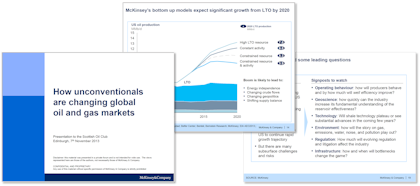
USPS Future Business Model (2010)
39 page deck describing the recent context and base case going forward for USPS, as well as potential change levers and what is required to change course short term. Good inspiration for: Structuring a coherent strategy document with a clear storyline.
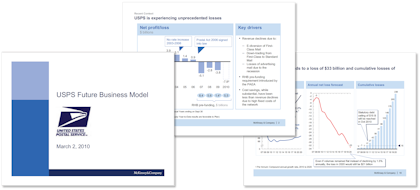
Capturing the full electricity efficiency potential of the U.K. (2012)
61 page main deck + 68 page appendix covering a full analysis and recommendations for becoming more energy efficient. Appears to have been prepared for the UK government. Excellent deck with many good slide designs and the full end-to-end storyline from baseline calculation to potential efficiency measures to barriers to prioritization and recommendations of measures to take. Good inspiration for : Creating a full report of a project analysis and recommendations based on that analysis. Presenting data in clear slides. Presenting and analyzing potential measures systematically.
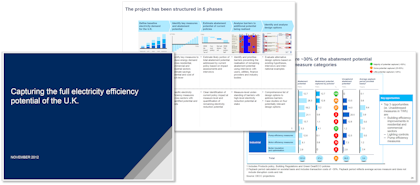
Modelling the potential of digitally-enabled processes, transparency and participation in the NHS (2014)
3 page deck + 13 page appendix describing the context, methodology, and outcome of a quantitative model to analyze the net benefits of various technology interventions for the NHS. Also includes an analysis of the net opportunities against the ease of implementation, and ends with a recommendation of the four most impactful actions to take. Good inspiration for: Structuring and explaining a quantitative model including drivers and expected impact.
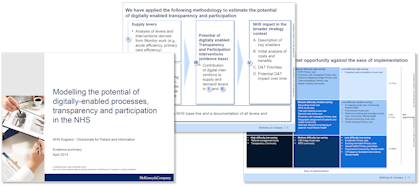
Refueling the innovation engine in vaccines (2016)
40 page discussion document for NVAC as part of a longer project. The deck goes over the state of the industry, challenges to innovation and potential solutions, as well as what role NVAC can play. Good inspiration for: Creating a clear and structured storyline that balances data-heavy slides with verbal/abstract slides.
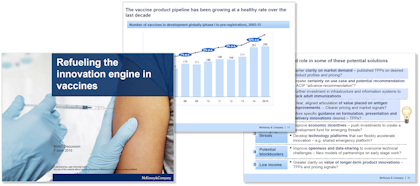
Industry reports & market overviews:
The changed agenda in the global sourcing industry: perspectives and developments (2009) 35 page dense deck presented at a Global ICT services sourcing conference. Covers the development of the onshore-offshore industry, what it is expected to look like going forward, and the imperatives for management to successfully navigate the future. Good inspiration for: Creating a complete and comprehensive market picture, as well as framing recommendations.
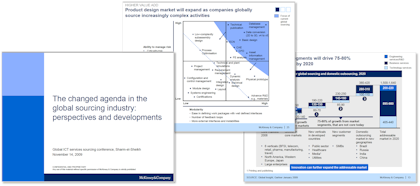
What Makes Private Sector Partnership Works: some learnings from the field (2011) 12 page deck describing public-private partnerships around agriculture in Africa. The deck identifies where in the value chain there could be partnership possibilities, as well as examples of successful partnerships and what is needed to succeed. Good inspiration for: Presenting a value chain. Visually representing different partnership models (or other types of models).
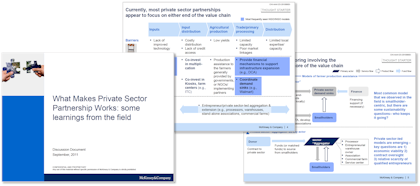
The Internet of Things and Big Data: Opportunities for Value Creation (2013) 18 page picture-heavy deck used in an oral presentation around the topic of IoT and big data. The deck first describes IoT’s growth in recent years before moving into how IoT works on a high level and what the possibilities and challenges are.
Good inspiration for: Using quotes to enhance a storyline.
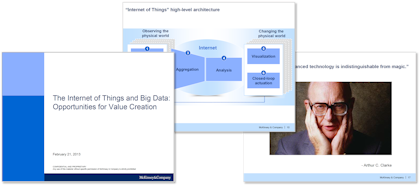
Laying the foundations for a financially sound industry (2013) 17 page deck going over the current financial situation of the global steel industry before briefly touching on the outlook and then discussing possible measures to become more financially stable. Contains a fairly detailed and interesting EBITDA model with different drivers of EBITDA laid out. Presented at a Steel Committee meeting. Good inspiration for: Creating clear graph slides. Visually representing a quantitative model.
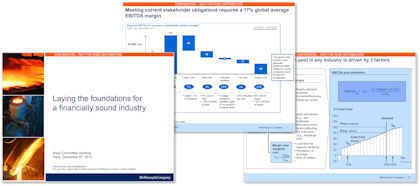
Manufacturing the Future: The Next Era of Global Growth and Innovation (2013) 38 page deck covering the current state of US manufacturing and five disruptive trends that are reshaping the industry. Good inspiration for: Summarizing trends and relating them to a specific value chain. Many good graphs and ways of presenting data (both quantitative and qualitative) visually.
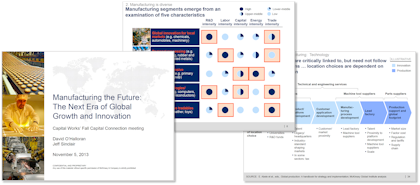
Insurance trends and growth opportunities for Poland (2015) 25 page deck covering the status of the Polish insurance market and five main trends shaping the market, as well as a case of a different market and how that has changed. Presented in connection with the Polish Insurance Association. Good inspiration for: Systematically presenting various trends and their expected impact without becoming too monotonous visually.
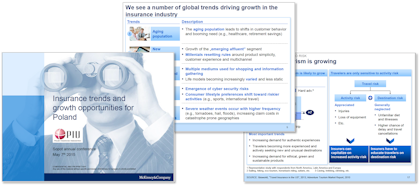
Challenges in Mining: Scarcity or Opportunity? (2015) 10 page main deck + 30 page appendix describing the current status of mining and how the value chain will potentially change due to new innovations. Presented during World Materials Forum. Good inspiration for: Presenting a value chain in different ways, as well as which areas of the value chain will change/can be innovated.
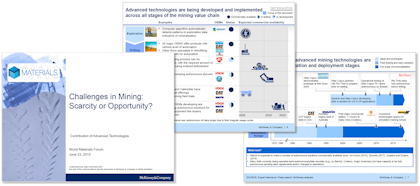
Restoring Economic Health to the North Sea (2015) 28 page deck used for an oral presentation about the cost increases in the UK oil industry and potential ways to mitigate these. Good inspiration for: Creating a simple and clear storyline with a strong narrative arc that works well for a live presentation.
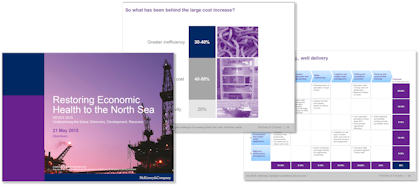
How will Internet of Things, mobile internet, data analytics and cloud transform public services by 2030? (2015) 15 page fairly high-level deck describing IoT and other digital trends and how they will potentially impact various industries and current ways of doing things. Good inspiration for: Presenting a trend and following with a good example/case study.
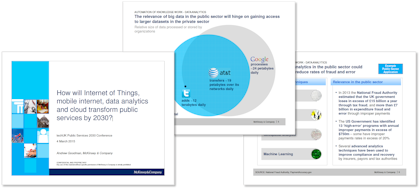
Five keys to unlocking growth in marketing’s “new golden age” (2017) 26 page deck going over five main levers to pull in marketing; science, substance, story, speed, and simplicity. Describes each lever in a few slides using mainly images, icons, and other graphics. Good inspiration for: Creating light, image-based slides that still tell a story and get the message across.
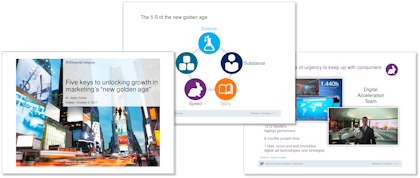
Using Artificial Intelligence to prevent healthcare errors from occurring (2017) 25 page dense deck describing how AI/ML (machine learning) is changing industries, the possible use cases in healthcare, and what barriers exists/which key things need to be in place to enable an advanced analytics implementation. Good inspiration for: Showing quantitative potentials for different use cases/levers and summarizing these in a visually clear way. Creating one-pagers on specific use cases.
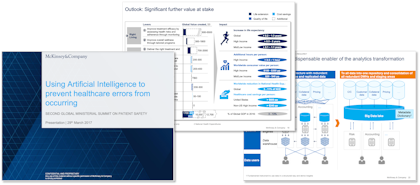
Digital Luxury Experience 2017 (2017) 24-page support deck for an oral presentation going over three areas of change for the luxury industry, hosted by a luxury goods umbrella organization. Good inspiration for: Using simple graphs and numbers to illustrate a point.
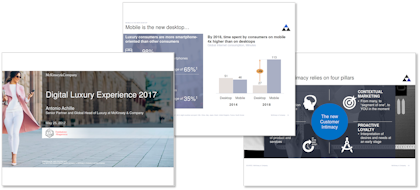
Technology’s role in mineral criticality (2017) 28 page deck first describing some overall technology trends and how they may impact the minerals industry including potential opportunities. Then going into productivity issues in mining and potential fixes, as well as a deep dive into two commodities. Presented at the World Materials Forum. Good inspiration for: Presenting complex data on relatively simple slides and making the message visually clear.
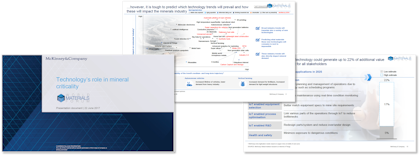
The future energy landscape: Global trends and a closer look at the Netherlands (2017) 38 page graph-heavy deck describing the current energy landscape and three major trends expected to impact it going forward, as well as how it specifically applies to the Netherlands. Presentation to the Dutch financial sector. Good inspiration for: Different ways of presenting numbers and graphs in clear, compelling visuals.
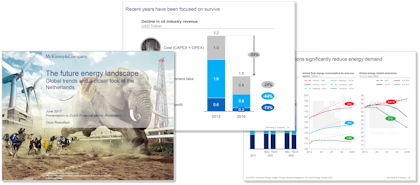
European Banking Summit 2018 (2018) 10-page deck going over the status of European capital markets, particularly concerning the US. Mainly focused on current numbers, not a lot on the path forward. Good inspiration for: Making classic consulting-style graph slides.
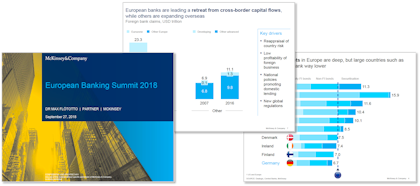
Current perspectives on Medical Affairs in Japan (2018) 20 page deck covering the current status and trends impacting Medical Affairs in Japan, as well as four priorities for leadership going forward. Good inspiration for: Creating divider slides that also function as executive summaries.
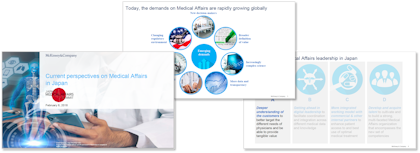
Investment and Industrial Policy: A Perspective on the Future (2018) 16-page main deck + 7-page appendix describing the rise of globalization, its impact on economic growth, and recommendations for policy-makers. Fairly high-level, although with some good data slides. Presented as part of a panel discussion at the UNCTAD Trade And Development Board. Good inspiration for: Creating visually clear data-heavy slides. Condensing a potentially long storyline into a few key slides.
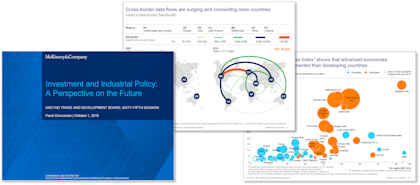
Moving Laggards to Early Adopters (Maybe even innovators) (2018) 18 page word-heavy deck used in an oral presentation on the topic of digitalization in manufacturing. Covers the challenges of digital manufacturing, then goes over survey output from the industry, before ending with three recommendations for businesses. Good inspiration for: Presenting verbal findings and recommendations in simple slides with icons.
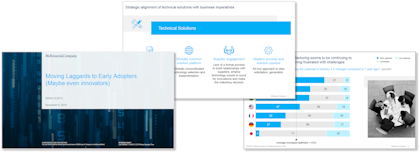
The Future of the Finance Function –Experiences from the U.S. public sector (2019) 14 page deck used in an oral presentation for a government finance function conference. The deck goes over what challenges CFOs etc. face in the current environment and five ways to move from transaction to value management going forward. Good inspiration for: Presenting different levels of maturity of a given function and supporting this with data.
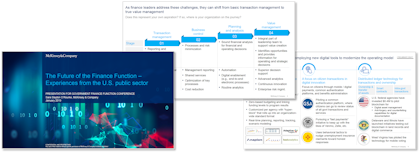
Fab automation - Artificial Intelligence (date unknown) 17 page deck discussing the potential for AI in the semiconductor industry by first describing what AI is, then how it applies to fab, and finally what is required to unlock that potential. Good inspiration for: Creating different types of slide designs that balance text and numbers to avoid a monotonous or boring storyline.
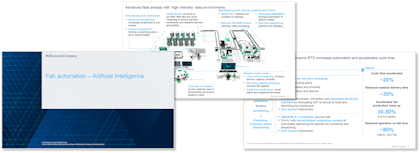
McKinsey Global Institute reports:
Context for Global Growth and Development (2014) Sub-title: Extracts from McKinsey Global Institute research for UN Session on “Financing for global sustainable development”. 11-page deck focusing mainly on key findings from a longer research report put out by McKinsey Global Institute. Good inspiration for: Creating different slide designs for graphs and numbers.
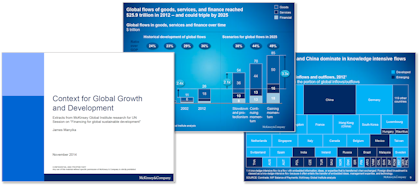
Perspectives on manufacturing, disruptive technologies, and Industry 4.0 (2014) 17-page slightly ad hoc deck with extracts of a longer report put out by the McKinsey Global Institute on manufacturing. Goes over why manufacturing is important, how the boundaries of industry and services are blurring, how digital manufacturing is growing, and finally where governments can support from a policy perspective. Good inspiration for: Different slide designs and presenting data in a visually appealing and clear way.
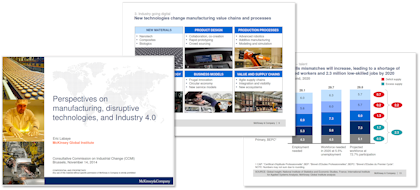
From poverty to empowerment: India’s imperative for jobs, growth and effective basic services (2014) 13-page deck + 8-page appendix going over India’s poverty issues and potential change levers. Extract of a longer report put out by the McKinsey Global Institute. Good inspiration for: Creating clear and compelling quantitative slides in different formats.
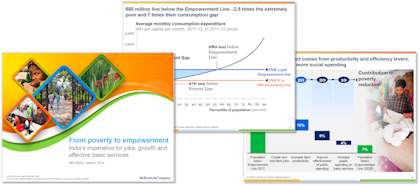
Attracting Responsible Mining Investment in Fragile and Conflict Affected Settings (2014) 8 page deck describing the development of resource-driven countries and six dimensions for governments to focus on to realize the full potential going forward. Extract from a longer report put out by the McKinsey Global Institute. Good inspiration for: Creating a short and to-the-point storyline following the SCQA framework (situation-complication-question-answer), although the “Q” is implied.
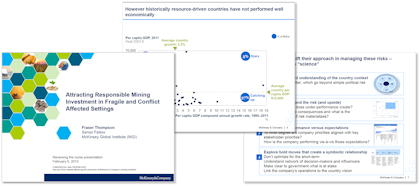
A blueprint for addressing the global affordable housing challenge (2015) 49 page deck going into first what the affordable housing challenge looks like in numbers, followed by levers to narrow the affordability gap. The deck is a summation of a longer report put out by the McKinsey Global Institute. Good inspiration for: Illustrating change levers and their quantitative impact, both collectively and separately.
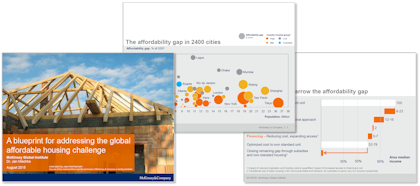
Jobs lost, jobs gained: Workforce transitions in a time of automation (2017) 16-page deck going over how automation and computers have historically affected jobs, and what potential impact it will have in the future. Summary of a longer report put out by the McKinsey Global Institute. Good inspiration for: Creating data-heavy slides. Keeping the storyline simple and to-the-point.
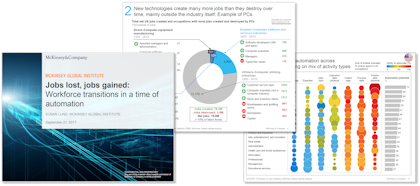
Reinventing Construction: A Route To Higher Productivity (2017) 14-page deck describing the current state of construction, in particular productivity, before briefly going over seven potential improvement areas and how government intervention might help. Very high-level deck summarizing a longer report by the McKinsey Global Institute. Good inspiration for: Using an agenda or divider slide actively to both summarize and outline the storyline.
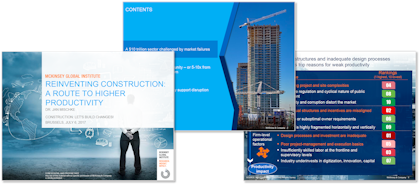
Outperformers: High-growth emerging economies and the companies that propel them (2018) 16-page deck describing the main highlights of a research report by McKinsey Global Institute on high-growth emerging economies. The deck first goes over the data on how these economies are performing, followed by the proposed reasons why, and the outlook going forward. Good inspiration for: Creating different graph-heavy slide designs.
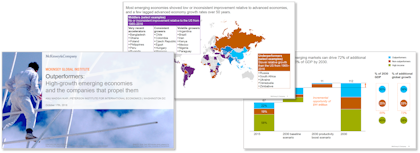
How companies can capture the veteran opportunity (2012)
34-page main deck + 12 page appendix going into how employers can leverage veteran talent. The document is divided into three main sections; 1) what is the business case for hiring veterans, 2) what are the best practices are for finding, hiring, onboarding, and retaining veterans, 3) what resources are available to assist employers’ veteran recruiting efforts. Good inspiration for: Systematically presenting an opportunity and how to best leverage that opportunity. Creating slides to show processes and decision trees.
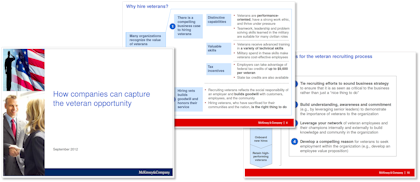
The Five Frames – A Guide to Transformational Change (date unknown)
33-page deck discussing organizational “health” and diving into a five-step approach to transformation. The deck is structured as a kind of simple playbook to use when undertaking e.g. a digital transformation. Good inspiration for: Directly applicable high-level playbook when embarking on a small or large transformation. Structuring a process.
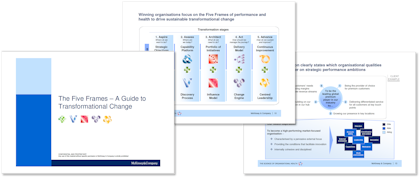
Download our most popular templates
High-end PowerPoint templates and toolkits created by ex-McKinsey, BCG, and Bain consultants
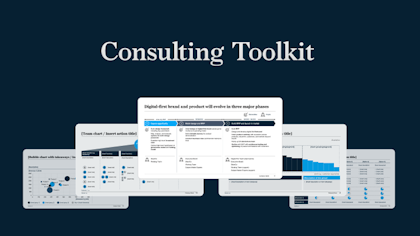
Consulting toolkit and template
A comprehensive library of slide layouts, templates, and typically consulting tools and frameworks.
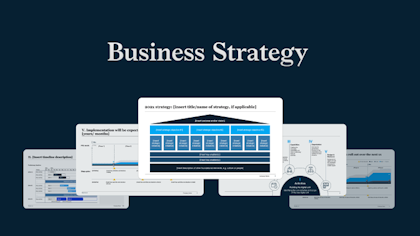
- Business Strategy
This template, created by ex-McKinsey and BCG consultants, includes everything you need to create a complete strategy.
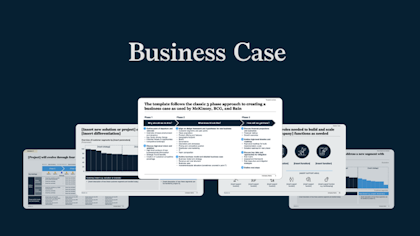
Create a full business case incl. strategy, roadmap, financials and more.
Related articles
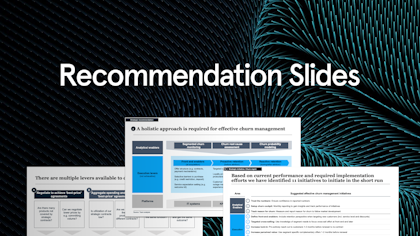
How to Write Recommendation Slides Like a Consultant (Examples and Template)
In this article, we discuss what a Recommendation slide is, how it is different from a Next Steps slide, and how to create a best practice version with examples from McKinsey, BCG, and Bain decks.
May 9, 2024
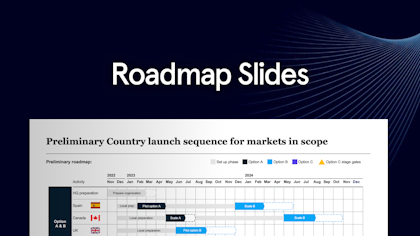
How to Write Roadmap Slides Like a Consultant (Examples and Template)
Roadmap Slides function like a map, laying out the key milestones, goals, activities, and timelines for achieving a particular objective. In this post, we will explore various roadmap slides and offer a few tips and tricks for building your own.
Apr 25, 2024
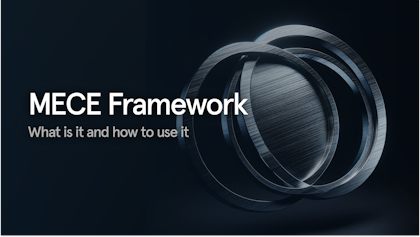
What is the MECE Framework – McKinsey Toolbox
In this post, we cover the MECE principle and how you can apply it to sharpen your thinking and simplify complex ideas into something that can easily be understood.
Dec 6, 2023

- Consulting Toolkit
- Market Analysis
- Market Entry Analysis
- Due Diligence Report
- Mergers & Acquisitions
- Digital Transformation
- Product Strategy
- Go-To-Market Strategy
- Operational Excellence I
- Operational Excellence II
- Operational Excellence III
- Consulting PowerPoint Templates
- How it works
- Terms & Conditions
- Privacy Policy
© 2023 Slideworks. All rights reserved
Denmark : Farvergade 10 4. 1463 Copenhagen K
US : 101 Avenue of the Americas, 9th Floor 10013, New York

Hacking the Case Interview

Merger & acquisition (M&A) cases are a common type of case you’ll see in consulting interviews. You are likely to see at least one M&A case in your upcoming interviews, especially at consulting firms that have a large M&A or private equity practice.
These cases are fairly straight forward and predictable, so once you’ve done a few cases, you’ll be able to solve any M&A case.
In this article, we’ll cover:
- Two types of merger & acquisition case interviews
- The five steps to solve any M&A case
- The perfect M&A case interview framework
- Merger & acquisition case interview examples
- Recommended M&A case interview resources
If you’re looking for a step-by-step shortcut to learn case interviews quickly, enroll in our case interview course . These insider strategies from a former Bain interviewer helped 30,000+ land consulting offers while saving hundreds of hours of prep time.
Two Types of Merger & Acquisition Case Interviews
A merger is a business transaction that unites two companies into a new and single entity. Typically, the two companies merging are roughly the same size. After the merger, the two companies are no longer separately owned and operated. They are owned by a single entity.
An acquisition is a business transaction in which one company purchases full control of another company. Following the acquisition, the company being purchased will dissolve and cease to exist. The new owner of the company will absorb all of the acquired company’s assets and liabilities.
There are two types of M&A cases you’ll see in consulting case interviews:
A company acquiring or merging with another company
- A private equity firm acquiring a company, also called a private equity case interview
The first type of M&A case is the most common. A company is deciding whether to acquire or merge with another company.
Example: Walmart is a large retail corporation that operates a chain of supermarkets, department stores, and grocery stores. They are considering acquiring a company that provides an online platform for small businesses to sell their products. Should they make this acquisition?
There are many reasons why a company would want to acquire or merge with another company. In making an acquisition or merger, a company may be trying to:
- Gain access to the other company’s customers
- Gain access to the other company’s distribution channels
- Acquire intellectual property, proprietary technology, or other assets
- Realize cost synergies
- Acquire talent
- Remove a competitor from the market
- Diversify sources of revenue
A private equity firm acquiring a company
The second type of M&A case is a private equity firm deciding whether to acquire a company. This type of M&A case is slightly different from the first type because private equity firms don’t operate like traditional businesses.
Private equity firms are investment management companies that use investor money to acquire companies in the hopes of generating a high return on investment.
After acquiring a company, a private equity firm will try to improve the company’s operations and drive growth. After a number of years, the firm will look to sell the acquired company for a higher price than what it was originally purchased for.
Example: A private equity firm is considering acquiring a national chain of tattoo parlors. Should they make this investment?
There are a few different reasons why a private equity firm would acquire a company. By investing in a company, the private equity firm may be trying to:
- Generate a high return on investment
- Diversify its portfolio of companies to reduce risk
- Realize synergies with other companies that the firm owns
Regardless of which type of M&A case you get, they both can be solved using the same five step approach.
The Five Steps to Solve Any M&A Case Interview
Step One: Understand the reason for the acquisition
The first step to solve any M&A case is to understand the primary reason behind making the acquisition. The three most common reasons are:
- The company wants to generate a high return on investment
- The company wants to acquire intellectual property, proprietary technology, or other assets
- The company wants to realize revenue or cost synergies
Knowing the reason for the acquisition is necessary to have the context to properly assess whether the acquisition should be made.
Step Two: Quantify the specific goal or target
When you understand the reason for the acquisition, identify what the specific goal or target is. Try to use numbers to quantify the metric for success.
For example, if the company wants a high return on investment, what ROI are they targeting? If the company wants to realize revenue synergies, how much of a revenue increase are they expecting?
Depending on the case, some goals or targets may not be quantifiable. For example, if the company is looking to diversify its revenue sources, this is not easily quantifiable.
Step Three: Create a M&A framework and work through the case
With the specific goal or target in mind, structure a framework to help guide you through the case. Your framework should include all of the important areas or questions you need to explore in order to determine whether the company should make the acquisition.
We’ll cover the perfect M&A framework in the next section of the article, but to summarize, there are four major areas in your framework:
Market attractiveness : Is the market that the acquisition target plays in attractive?
Company attractiveness : Is the acquisition target an attractive company?
Synergies : Are there significant revenue and cost synergies that can be realized?
Financial implications : What are the expected financial gains or return on investment from this acquisition?
Step Four: Consider risks OR consider alternative acquisition targets
Your M&A case framework will help you investigate the right things to develop a hypothesis for whether or not the company should make the acquisition.
The next step in completing an M&A case depends on whether you are leaning towards recommending making the acquisition or recommending not making the acquisition.
If you are leaning towards recommending making the acquisition…
Explore the potential risks of the acquisition.
How will the acquisition affect existing customers? Will it be difficult to integrate the two companies? How will competitors react to this acquisition?
If there are significant risks, this may change the recommendation that you have.
If you are leaning towards NOT recommending making the acquisition…
Consider other potential acquisition targets.
Remember that there is always an opportunity cost when a company makes an acquisition. The money spent on making the acquisition could be spent on something else.
Is there another acquisition target that the company should pursue instead? Are there other projects or investments that are better to pursue? These ideas can be included as next steps in your recommendation.
Step Five: Deliver a recommendation and propose next steps
At this point, you will have explored all of the important areas and answered all of the major questions needed to solve the case. Now it is time to put together all of the work that you have done into a recommendation.
Structure your recommendation in the following way so that it is clear and concise:
- State your overall recommendation firmly
- Provide three reasons that support your recommendation
- Propose potential next steps to explore
The Perfect M&A Case Interview Framework
The perfect M&A case framework breaks down the complex question of whether or not the company should make the acquisition into smaller and more manageable questions.
You should always aspire to create a tailored framework that is specific to the case that you are solving. Do not rely on using memorized frameworks because they do not always work given the specific context provided.
For merger and acquisition cases, there are four major areas that are the most important.
1. Market attractiveness
For this area of your framework, the overall question you are trying to answer is whether the market that the acquisition target plays in is attractive. There are a number of different factors to consider when assessing the market attractiveness:
- What is the market size?
- What is the market growth rate?
- What are average profit margins in the market?
- How available and strong are substitutes?
- How strong is supplier power?
- How strong is buyer power?
- How high are barriers to entry?
2. Company attractiveness
For this area of your framework, the overall question you want to answer is whether the acquisition target is an attractive company. To assess this, you can look at the following questions:
- Is the company profitable?
- How quickly is the company growing?
- Does the company have any competitive advantages?
- Does the company have significant differentiation from competitors?
3. Synergies
For this area of your framework, the overall question you are trying to answer is whether there are significant synergies that can be realized from the acquisition.
There are two types of synergies:
- Revenue synergies
- Cost synergies
Revenue synergies help the company increase revenues. Examples of revenue synergies include accessing new distribution channels, accessing new customer segments, cross-selling products, up-selling products, and bundling products together.
Cost synergies help the company reduce overall costs. Examples of cost synergies include consolidating redundant costs and having increased buyer power.
4. Financial implications
For this area of your framework, the main question you are trying to answer is whether the expected financial gains or return on investment justifies the acquisition price.
To do this, you may need to answer the following questions:
- Is the acquisition price fair?
- How long will it take to break even on the acquisition price?
- What is the expected increase in annual revenue?
- What are the expected cost savings?
- What is the projected return on investment?
Merger & Acquisition Case Interview Examples
Let’s put our strategy and framework for M&A cases into practice by going through an example.
M&A case example: Your client is the second largest fast food restaurant chain in the United States, specializing in serving burgers and fries. As part of their growth strategy, they are considering acquiring Chicken Express, a fast food chain that specializes in serving chicken sandwiches. You have been hired to advise on whether this acquisition should be made.
To solve this case, we’ll go through the five steps we outlined above.
The case mentions that the acquisition is part of the client’s growth strategy. However, it is unclear what kind of growth the client is pursuing.
Are they looking to grow revenues? Are they looking to grow profits? Are they looking to grow their number of locations? We need to ask a clarifying question to the interviewer to understand the reason behind the potential acquisition.
Question: Why is our client looking to make an acquisition? Are they trying to grow revenues, profits, or something else?
Answer: The client is looking to grow profits.
Now that we understand why the client is considering acquiring Chicken Express, we need to quantify what the specific goal or target is. Is there a particular profit number that the client is trying to reach?
We’ll need to ask the interviewer another question to identify this.
Question: Is there a specific profit figure that the client is trying to reach within a specified time period?
Answer: The client is trying to increase annual profits by at least $200M by the end of the first year following the acquisition.
With this specific goal in mind, we need to structure a framework to identify all of the important and relevant areas and questions to explore. We can use market attractiveness, company attractiveness, synergies, and financial implications as the four broad areas of our framework.
We’ll need to identify and select the most important questions to answer in each of these areas. One potential framework could look like the following:

Let’s fast forward through this case and say that you have identified the following key takeaways from exploring the various areas in your framework:
- Chicken Express has been growing at 8% per year over the past five years while the fast food industry has been growing at 3% per year
- Among fast food chains, Chicken Express has the highest customer satisfaction score
- Revenue synergies would increase annual profit by $175M. This is driven by leveraging the Chicken Express brand name to increase traffic to existing locations
- Cost synergies would decrease annual costs by $50M due to increased buyer power following the acquisition
At this point, we are leaning towards recommending that our client acquire Chicken Express. To strengthen our hypothesis, we need to explore the potential risks of the acquisition.
Can the two companies be integrated smoothly? Is there a risk of sales cannibalization between the two fast food chains? How will competitors react to this acquisition?
For this case, let’s say that we have investigated these risks and have concluded that none of them pose a significant threat to achieving the client’s goals of increasing annual profit by $200M.
We’ll now synthesize the work we have done so far and provide a clear and concise recommendation. One potential recommendation may look like the following:
I recommend that our client acquires Chicken Express. There are three reasons that support this.
One, Chicken Express is an attractive acquisition target. They are growing significantly faster than the fast food industry average and have the highest customer satisfaction scores among fast food chains.
Two, revenue synergies would increase annual profit by $175M. The client can leverage the brand name of Chicken Express to drive an increase in traffic to existing locations.
Three, cost synergies would decrease annual costs by $50M. This is due to an increase in buyer power following the acquisition.
Therefore, our client will be able to achieve its goal of increasing annual profits by at least $200M. For next steps, I’d like to assess the acquisition price to determine whether it is reasonable and fair.
More M&A case interview practice
Follow along with the video below for another merger and acquisition case interview example.
For more practice, check out our article on 23 MBA consulting casebooks with 700+ free practice cases .
In addition to M&A case interviews, we also have additional step-by-step guides to: profitability case interviews , market entry case interviews , growth strategy case interviews , pricing case interviews , operations case interviews , and marketing case interviews .
Recommended M&A Case Interview Resources
Here are the resources we recommend to learn the most robust, effective case interview strategies in the least time-consuming way:
- Comprehensive Case Interview Course (our #1 recommendation): The only resource you need. Whether you have no business background, rusty math skills, or are short on time, this step-by-step course will transform you into a top 1% caser that lands multiple consulting offers.
- Hacking the Case Interview Book (available on Amazon): Perfect for beginners that are short on time. Transform yourself from a stressed-out case interview newbie to a confident intermediate in under a week. Some readers finish this book in a day and can already tackle tough cases.
- The Ultimate Case Interview Workbook (available on Amazon): Perfect for intermediates struggling with frameworks, case math, or generating business insights. No need to find a case partner – these drills, practice problems, and full-length cases can all be done by yourself.
- Case Interview Coaching : Personalized, one-on-one coaching with former consulting interviewers
- Behavioral & Fit Interview Course : Be prepared for 98% of behavioral and fit questions in just a few hours. We'll teach you exactly how to draft answers that will impress your interviewer
- Resume Review & Editing : Transform your resume into one that will get you multiple interviews
Land Multiple Consulting Offers
Complete, step-by-step case interview course. 30,000+ happy customers.
How to master M&A consulting case studies?

M&A deals can involve huge sums of money. For instance, the beer company AB InBev spent $130bn on SAB Miller, one of its largest competitors, in 2015. As a comparison, South Africa's GDP was ~$300bn the same year.
These situations can be extremely stressful for companies' executives both on the buying and selling sides. Most CEOs only do a handful of acquisitions in their career and are therefore not that familiar with the process. If things go wrong, they could literally lose their job.
As a consequence, management consultants are often brought into these situations to help. Most top firms including McKinsey, BCG and Bain have Partners specialised in helping CEOs and CFOs navigate M&A.
There is therefore a good chance that you will come across an M&A case study at some point in your consulting interviews . Preparing for this situation is important. Let's first step through why companies buy each other in the first place. Second, let's discuss how you should structure your framework in an M&A case interview. And finally, let's practice on an M&A case example.
Click here to practise 1-on-1 with MBB ex-interviewers
Why do companies buy each other.
Imagine you are the CEO of a large beer company called AB InBev. What are the reasons you would decide to buy your competitor SAB Miller? Let's step through the three most common ones.
Reason #1: Undervaluation
The first reason you might decide to buy SAB Miller is that you think it is undervalued by the stock market. For instance, SAB Miller owns leading beer brands in Africa and China. And your analysis might suggest that beer consumption in these markets is going to grow even faster than everyone else expects. The stock market might value SAB Miller at $130bn, but you think it is actually worth $150bn because of the insights you on have on Africa and China. If that's only reason you are buying, you would behave as a pure financial investor.
Reason #2: Control
The second reason you might buy SAB Miller is that you think it is poorly managed and you can do a better job than the current management if you get control. For instance, you might think that SAB Miller's marketing team really isn't doing a good job. The current revenues of the company are $50bn, but you estimate that you can grow these revenues to $55bn by adjusting the marketing messages and without spending additional money. In that case, you'll pay $130bn for SAB Miller today, but once you've adjusted the marketing strategy and increased revenues, it will be worth much more.
Reason #3: Synergies
The final reason you might buy SAB Miller for $130bn is that you think you can create value by combining it with your own company. Let's assume AB InBev was worth $200bn at the time of the purchase. As the CEO you could have reasons to believe that the combination of both companies would be worth MORE than the individual parts; i.e. more than $330bn ($200bn + $130bn). For instance, if you combine both entities, you might decide to keep the AB InBev marketing team and to let go the SAB Miller one. The combined entity would maintain the same revenues but have lower costs and therefore higher profits. This is what's called synergies.
Having a high-level understanding of the three concepts above is more than enough for the purpose of case interview preparation . But if you are interested in the topic and would like to read more about it, we would recommend the following McKinsey article about successful acquisition strategies .
M&A case framework
Right, now that you have a high-level understanding of why companies buy each other in the first place, let's discuss the framework you should use to analyse the transaction.
Partners at McKinsey, BCG and Bain typically look at 4 areas when working on M&A cases. Let's step through them one by one and list the questions you'd want to answer in each.
1. The market
The first area consultants typically analyse in M&A cases is the market. This is extremely important because a big part of the success or failure of the acquisition will depend on broader market dynamics. Here are some of the questions you could look into:
- Are both companies (buyer / target) in the same markets (e.g. geographies, customers, etc.)?
- How big is the market? And how fast is it growing?
- How profitable is the market? And is its profitability stable?
- How intense is the competition? Are there more and more players?
- How heavily regulated is the market? Are there barriers to entry?
2. The target
The second important area to analyse is the company you are thinking of acquiring (i.e. the target). Your overall objective here will be to understand how attractive it is both financially and strategically.
- What is the current and future financial position of the target (e.g.: revenues, profits, etc.)? Is it under / overvalued?
- Does the target own any assets (e.g.: technology, brands, etc.) or capabilities (e.g.: manufacturing know-how) that are strategically important to the buyer?
- What's the quality of the current management? Do we believe we can add value by getting control and running the company better?
- Is the target company's culture very different? If so, are we confident it could still integrate well with the buyer?
3. The buyer
The third area consultants typically analyse is the buyer (i.e. the company buying the target). It is important to have a good understanding of what's motivating the purchase the target and whether the buyer has adequate financial resources.
- What's the acquisition rationale? Undervaluation, control, synergies or a combination?
- Can the buyer easily finance the acquisition? Or will it need to lend money?
- Does the buyer have any experience in integrating companies? Was it successful in the past?
- Is this the right time for the buyer to acquire another player? Does it risk losing focus?
4. Synergies and risks
And finally, the last area to analyse is the synergies and risks related to the acquisition. This is usually the hardest part of the analysis as it is the most uncertain.
- What is the value of the individual and combined entities?
- Are there cost synergies (e.g.: duplication of roles, stronger buying power, etc.)?
- Are there revenue synergies (e.g.: product cross-selling, using the target's distribution channels for the buyer's products, etc.)?
- What are the biggest risks that could make the acquisition fail (e.g. culture fit, regulation, etc.)?
It is almost impossible to cover all these aspects in a 40mins case interview. Once you will have laid out your framework, your interviewer will then typically make you focus on a specific area of the framework for the rest of the case. This is usually the market, or the target company. But can also sometimes be the other two points.
M&A case examples
Ok, now that you know how to analyse M&A situations, let's step through a few real life examples of acquisitions and their rationale. For each example, you should take a few minutes to apply the framework you've just learned. Once you have done that, you can then read the actual acquisition rationale.
Situation #1: At the beginning of the 2010s, IBM went on an acquisition spree and purchased 43 companies over 3 years for an average of $350 million each. All of these companies had smaller scale than IBM and slightly different technology.
Rationale: The main reason IBM decided to buy these 40+ companies is that they could all benefit from the firm's global sales force. Indeed IBM has a presence in the largest software markets in the world (e.g. North America, Europe, etc.) that smaller companies just don't have. IBM estimates that thanks to its footprint it could accelerate the growth of the companies it purchased by more than 40 percent over the two years following the acquisition in some cases. This is a typical product distribution synergy.
Situation #2: In 2010, Apple decided to buy Siri, its now famous voice assistant. And in 2014, it decided to purchase Beats Electronics which had just launched a music streaming business. Both acquisitions were motivated by similar reasons.
Rationale: In both the Siri and Beats cases, Apple had the capabilities to develop the technology / product it was purchasing itself. It could have built its own voice assistant, and its own music streaming business. But it decided not to. The reason they thought it would be better to buy a competitor is that it was going to enable them to offer these solutions to their customers QUICKER. To be more precise, they probably estimated that offering these products quicker was worth more money than the savings they would make by developping the technology on their own. This is a typical revenue synergy that's widespread in the technology space.
Situation #3: Volkswagen, Audi and Porsche have been combined companies since 2012. Mergers are common in the automative industry and usually motivated by a central reason.
Rationale: The cost to develop a new car platform is really high. It takes years, hundreds of people and millions of dollars. By belonging to the same group, Volkswagen, Audi and Porsche can actually share car platforms and reuse them for different models with different brands. For instance, the Audi Q7, the Porsche Cayenne and the VW Tourage all run on the same underlying platform. This is a typical cost synergy.
Acquisitions are high-stake situations during which CEOs often feel they need the support of consultants. You should therefore expect to come across M&A cases at some point during your interviews. That being said, your interviewer won't expect you to be an M&A expert. Having a high-level understanding of what motivates companies to buy each other as well as knowing the framework listed above should be sufficient M&A knowledge.
After all, M&A cases, are normal case interviews. What will determine if you succeed or not is your ability to think and communicate in a structured way, not your detailed knowledge of how M&A works. So it's a good idea to spend some time on M&A cases, but don't let it distract you from your broader case interview preparation.
Mock interviews
The best way to improve at case interviews is to practise interviewing out loud, and you can do that in three main ways:
- Interview yourself (out loud)
- Practise interviewing with friends or family
- Practise interviewing with ex-interviewers
Practising by yourself is a great way to get started, and can help you get more comfortable with the flow of a case interview. However, this type of practice won’t prepare you for realistic interview conditions.
After getting some practice on your own, you should find someone who can do a mock interview with you, like a friend or family member.
We’d also recommend that you practise 1-1 with ex-interviewers from top consulting firms . This is the best way to replicate the conditions of a real case interview, and to get feedback from someone who understands the process extremely well.
Click here to book your mock case interview.

Top 10 Case Interview Frameworks: Beginner Mistakes
“Which framework to use?” is probably among the most common questions popping up in a candidate’s mind when confronting a case.
This definitive guide will not only answer that question by introducing a few common frameworks, but also tell you HOW to use those frameworks more effectively during case interviews , and what pitfalls you should be aware of.
Table of Contents

Case interview frameworks – Overview
What are case interview frameworks.
Case interview frameworks are templates used to break down and solve business problems in case interviews. A framework can be off-the-shelf or highly customized for specific cases; it can also be tailored for certain functions/industries, or versatile enough for general problem-solving.
Common case interview frameworks include:
- Profitability Framework
- Business Situation Framework
- McKinsey M&A Framework
- 4P and 7P Frameworks
- Porter Five Forces Model
External vs Internal
Qualitative vs quantitative.
- Cost vs Benefits
- 2×2 Matrix (e.g.: BCG Growth-Share Matrix)
SWOT Analysis

All of these frameworks will be discussed later in this article.
During a case interview, you use consulting frameworks to break down the problem into smaller pieces through an issue tree and test each branch to see if the root-cause is in there. If a branch indeed contains the root-cause, you break it down further. Rinse and repeat until the root-cause is identified.
The big part of problem solving is about breaking down the problem in almost every step of the case.
What should I keep in mind when using consulting frameworks?
Templates should be treated as guidelines, and not strict rules . The same applies to case interview frameworks.
In the past, case interviews were much more predictable, and frameworks were more applicable. However, nowadays, case interviews are more similar to real business problems, where frameworks need a lot of customizations (you’ll see this word repeated a lot in this article) to be useful.
In fact, the whole consulting industry exists on the basis that consultants can customize theory to real, difficult business situations and produce positive results; nobody pays hundreds of thousands of dollars for them to recite a textbook – any college freshman can do as much.
That’s why in my Case Interview End-to-End Secrets Program , I don’t teach candidates to use frameworks – instead, the focus in on the fundamentals of case interview (problem-solving and business intuition) as well as the tips and techniques for instant performance improvement.
How can I use consulting frameworks effectively?
Here’s a problem with case interview beginners – they tend to go straight for the frameworks, before even knowing the basic mechanisms and principles of case interviews.
If you are one of those beginners, you must first grasp the basics of case interviews – the fundamentals of case interview problem-solving, the issue tree, and the MECE principle. I have written extensive, separate guides on these topics, but for starters, I advice you to read this Case Interview 101 comprehensive guide.
Busting case interview framework myths
Myth 1: “the more frameworks i know, the better”.
Before we proceed with the popular frameworks in consulting and case interviews, here are four huge myths about frameworks you should steer clear of.
Spend your time learning to draw customized frameworks/ issue trees instead. Case interviews are getting progressively more realistic and less conforming to specific frameworks, so trying to memorize dozens of frameworks is of no use.
Additionally, you should attend to the qualitative side of things, to deeply absorb each framework and its use; skimming the surface will come back to bite you later.
Myth 2: “There must be a framework out there that fits this case”
Ready-made frameworks CANNOT cover all kinds of situations. Even regarding the ones covered, existing frameworks are often “okay-fit”, but not perfectly fit.
Just create a framework/issue tree yourself. Nobody deducts your points for not using a ready-made tool, they even give you points if you can customize it.
Myth 3: “The fancier the framework, the more impressed the interviewer”
You are definitely not wooing anyone by being fancy-schmancy here. Nobody cares about your shiny frame if it does not fit with the picture.
Consultants are very practical and result-oriented people ; what impresses them are candidates who really know what they are talking about, and actually produce good results.
What’s worse is that you also run the risk of appearing superficial; it’s not difficult for consultants with years of experience in the field to fully expose your bluffing. If that happens you may as well say goodbye to your chance of getting hired.
Myth 4: “Knowledge of frameworks is irrelevant in interviewer-led cases”
The assumption underlying this myth is that in interviewer-led cases , the candidate is not the driver of the case, so he or she does not need to actively break down the problem.
This cannot be further from the truth. Many questions in interviewer-led cases are about frameworks/issue trees (“What factors would you consider to solve this problem?”).
Even with other question types you still need to structure answers like a mini-case. Appropriate knowledge of frameworks, as such, is still a MUST.
Five common case interview frameworks
Profitability framework.
Profitability is the most common problem type in case interviews – that means the Profitability Framework is the first one to master for every prospective consultant. You have to absolutely nail it every time, there’s no way around it.
In case interviews, the Profitability Framework is used to mathematically break down the problem, before switching to more qualitative frameworks to devise solutions.
Most of the time, the framework looks like this:
/article/public/1682497224186_blobid0.png)
What’s so good about it?
- Firstly, the Profitability Framework is a surefire way to draw a structured issue tree , as the framework is fundamentally MECE.
- Secondly, this framework is grounded in a simple mathematical basis – there’s no confusing qualitative concept to get lost in; heck, “revenues minus costs equal profits” is common sense. That’s why the Profitability Framework may as well be the easiest framework ever devised by humankind (or consultant-kind).
Are there any shortcomings I should be aware of?
- The Profitability Framework is generic; it may not reflect the nuances within the business enough to draw insightful conclusions. In businesses with wide price ranges, for example, just the total sales volume and average unit price do not tell you much.
- To extract more insightful information, either drill down quantitatively by introducing revenue/cost components not expressed in the basic framework (e.g.: revenue by product), or combine it with a qualitative framework.
Business situation framework
This is an extremely versatile template you can use in nearly every case, so make sure to learn it well. It’s not even a “should”, but a “must”.
In my video , I referred to the Business Situation Framework by the more tell-tale “3C & P”, based on it being derived from the famous 3C Framework. These four letters stand for “Company, Customers, Competitors, Products” – areas that the framework analyzes to yield solutions.
/article/public/1682497224193_blobid1.png)
- The one big advantage of the Business Situation Framework is its comprehensiveness – covering four crucial internal and external factors in business strategy.
- This framework is quite flexible – you can use it as a template to draw customized issue trees for all kinds of cases. In our video, I demonstrated this by applying it to solve an HR problem.
- The very same comprehensiveness making the Business Situation Framework flexible, also makes it generic, hence the need for extensive modifications; in many cases (the one in our video, for example), not all four components are relevant.
- It is not a beginner-friendly framework – it does not explicitly state which factors to consider under each main branch; newbies often end up in awkward situations, not knowing what to do next and thinking in a bottom-up manner.
How do you avoid that situation then? I’m inclined to say “practice”, but that much is obvious. A less obvious solution is to equip yourself with some “ninja tips” by learning how each C and P is usually segmented, although again I have to emphasize that it’s vital to maintain a flexible mindset.
McKinsey M&A framework
I absolutely love this one because it works in almost every single M&A case.
There isn’t an official name for this framework, but since it is used by McKinsey consultants when confronting an M&A issue, I’d just call it the “McKinsey M&A Framework”.
The framework assesses a proposed M&A on three dimensions: the stand-alone value of each involving companies (values, strengths, weaknesses, etc.); their synergy, i.e. will the two companies combined be greater than the sum of its parts; and other factors, such as feasibility, culture, legal issues, etc.
/article/public/1682497224212_blobid2.png)
- Firstly, the segmentation of stand-alone values and synergy is intrinsically MECE , helping the candidate cover all possibilities – every value of each company must fall into one of these categories.
- Secondly, the framework prompts the user to actively look for “Other factors”, increasing its suitability in unique circumstances.
Are there any shortcomings I should be aware of?
- The framework does not tell you what to look for in each branch, especially in the “Other factors” branch; this ambiguity shouldn’t be too much of an issue for experienced consultants, but might prove troublesome for candidates.
- Again, as with the previous Business Situation Framework, having a few ninja tricks up your sleeves should help you avoid getting stuck, just don’t rely on them too much.
4P / 7P Marketing Mix
This one is perhaps the single most popular framework in marketing. In case interviews , the 4P/7P Framework is used to formulate and implement marketing strategies for the supposed client, such as in competitive situation or market entry cases.
The original Marketing Mix covers four aspects – Product, Price, Place, and Promotion – thus, “4P”; note that “Place” does not pertain to any physical location, but the channel used by the company to deliver its products to its customers.
When services are involved, the mix becomes 7P; the new additions are: People – those performing the services; Process – how those services are delivered to the customers; and Physical Evidence – the visible, physical clues about the services (think of decorations inside a restaurant).
/article/public/1682497224215_blobid3.png)
- The best thing about this framework is its sole focus on marketing, making it very efficient for situations where marketing is the primary/only concern.
- Both the 4P and 7P variants are inherently narrow in scope; candidates must always be mindful that they are not covering the big picture with this framework. Only use them to develop marketing solutions.
- The 4P Marketing Mix, specifically, is not even comprehensive enough for some tangible products, such as high-end fashion, where People, Process and Physical Evidence make huge differences.
Porter’s five forces model
Porter’s Five Forces Model is best used when candidates ask for the case context surrounding the client company; this framework helps them know what to ask.
Michael Porter’s model analyzes how a company’s Competitors, Suppliers, Customers interact with it, as well as how New Entrants and Substitute Products might threaten its place in the industry; it produces a snapshot of the relative power the business holds over its industry environment.
/article/public/1682497224184_blobid4.png)
- The model’s coverage of the industry landscape is extensive, giving the candidate a vivid picture of the industry surrounding and interacting with the client in the case.
- This framework doesn’t give a clear answer as to what to do – that is its primary drawback; Porter’s model is not “deep” enough to answer such questions.
- The framework is not comprehensive enough for certain industries where political and legal issues, as well as complementary products, are major factors.
- Another thing to keep in mind: Don’t ever analyze a company with the Five Forces Model – the Five Forces Model describes the industry around that business, not the business itself.
Five mini-frameworks – All-purpose tools
These powerful mini-frameworks are probably the most under-appreciated problem-solving tools ever existed.
Mini-frameworks, like the larger frameworks, are also templates to break down information in a top-down, organized fashion.
Unlike their big cousins, however, these are almost never a primary or upper-most component of an issue tree. Furthermore, while common case interview frameworks are, to varying degrees, business-oriented, mini-frameworks are universal.
In this section, I’ll introduce you to five mini-frameworks I find most helpful in consulting case interviews. They feature prominently as supplements for larger frameworks in candidate-led cases , or stand-alone templates to answer questions in interviewer-led cases.
This is a quick and easy method to segment information about a particular entity. The internal branch concerns the inside of the said entity, such as functions within a company; the external branch describes anything outside that entity.
Here’s an example of this mini-framework as an adjunct to the Profitability Framework:
South Sea – a company specializing in bottled sauces – has found its profits going down badly for the past few years. They want you to find out what’s causing the problem.
You split their profits into revenues and costs; from the data provided, it seems like a revenue problem so you’re going into that branch first. How do you proceed?
/article/public/1682497224202_blobid5.png)
Here, a quick check can be performed by splitting the factors causing the decline into two groups – external and internal, then ask the interview if the declining profits are also experienced by other American airlines; “yes” suggests an external root cause while “no” suggests an internal one.
This method of segmentation is primarily used in evaluations. By dividing items into two MECE groups, it reduces confusion and minimizes the risk of missing an important item.
For illustration, we again look at the packaged food company in the previous example:
Turns out, South Sea has quite a few internal problems, in both their production and sales functions. Coincidentally, Wilhelm International is looking to acquire South Sea. Wilhelm controls an extensive distribution network, so the South Sea management is quite interested in the deal.
It’s your task to assess whether South Sea should accept Wilhelm’s offer of acquisition or not.
/article/public/1682497224210_blobid6.png)
For this task, I recommend using the McKinsey M&A Framework to break down the analysis into three branches: (1) South Sea’s stand-alone value, (2) its possible synergy with Wilhelm International, and of course (3) there must be an “Other factors” branch as well.
Within each branch, it’s possible to group items into quantitative (profits, growth rates) and qualitative (brand name, capabilities). This combination makes the analysis more MECE , and easier to work with.
Costs vs Benefits
This decision-making tool is pretty straightforward – if the benefits outweigh the costs, you go with that option. Otherwise, you’d be better off keeping your money under the mattress.
The Costs-and-Benefits analysis is a somewhat-business-centric twist of the omnipotent Pros-and-Cons. Both of these approaches work even better with weights attached to each evaluating criterion to reflect its impact.
Now, let’s check up on South Sea:
The acquisition is proven to be beneficial for both sides. With the sales problem solved, South Sea turns its attention to the production issue. The management considers replacing some technologies to improve product quality, but they are not sure if the investment will pay off.
How do you know if the investment is worthwhile?
/article/public/1682497224200_blobid7.png)
A simple Costs-and-Benefits breakdown would suffice.
For benefits you have the financial gains to consider, as well as non-financial benefits such as improved brand image (because surprisingly, people love good food!).
2×2 Matrix
The 2×2 Matrix is a decision-making tool where options are examined using two criteria, each of which forms an axis of the matrix.
How do you apply this matrix in South Sea’s case, then?
Wilhelm International, after acquiring South Sea, is looking to push the sales of South Sea’s products using its distribution chain. However, South Sea’s product portfolio is quite large, and each product line differs greatly in terms of sales, branding, and market growth rate.
You must select which product lines to focus on.
/article/public/1682497224185_blobid8.png)
The 2×2 matrix most famous in the business world, and also suitable for this case, is BCG’s Growth-Share Matrix, which uses market growth rate and market share as decision-making criteria. The position of a business on this matrix suggests whether to invest in, maintain, or discard that business.
SWOT stands for Strengths, Weaknesses, Opportunities, Threats.
This mini-framework is seldom used in case interviews and consulting work because it’s very generic; however, for a quick and easy evaluation of a company’s positioning within the industry context, the SWOT analysis works just fine.
In most case interviews, this is where you usually turn to the Marketing Mix or the Business Situation frameworks, but even a SWOT analysis may yield some insights.
Other case interview frameworks
Besides the ones we have covered, there are some other case interview frameworks and mini-frameworks worth looking into:
- Six Forces Model: a variant of Porter’s Five Forces, introducing “Complementary Products” into the analysis.
- Lauterborn’s 4C Framework: a more consumer-oriented variant of the 4Ps, designed for niche marketing.
- McKinsey 7S Framework: a framework used in McKinsey for analyzing organizational effectiveness.
- Ansoff Matrix (Product-Market Grid): a 2×2 matrix, designed for product-market strategizing.
Applying frameworks in case interviews
Here are my five rules to effectively implement frameworks in case interviews; if you follow these rules closely, you will absolutely nail the case.
Of these five rules, the first three are about getting the right framework, while the last two are about looking smart during interviews.
- Getting to know the case: “If you know your case and know your frameworks, you need not fear the result of a hundred case interviews” – always gather as much information as possible before and when you draw your issue tree .
- Bending the frameworks: don’t ever bend reality to your frameworks; bend your frameworks to reality; remove, add, or modify elements if necessary.
- Allying with the interviewer: ask the interviewer to help you break down the problem if you get stuck . How do you get him on your side then? By displaying overwhelming consulting traits .
- 13 Reasons why: “Why do you break down the problem that way?”, “Why do you want this piece of data?” – explain all your questions and decisions as if you stand before the US Congress, and before the interviewer asks you; consultants love accountable people.
- Frameworks-which-must-not-be-named: don’t ever explicitly say the names of the frameworks (“I’m going to use the McKinsey M&A Framework”); you would sound very rigid, bookish, or worse, arrogant; consultants don’t like big words without substance.
I’ll give you a brief case sample to see how these rules work in practice:
Interviewer: Our client today is a restaurant called BurgerQueen, located on US Highway 66. The restaurant has found its profits going down last year, your task is to find out the problem and give them a solution.
Candidate: Thank you for the very interesting case, I’m quite excited to solve it. Now, before we dive in,, I would like to playback the case to make sure that we perceive it the same way, ask a few questions for clarification, then announce my approach. Does that sound good to you?
Interviewer: Okay, carry on.
Candidate: Well, let’s see… Our client is a restaurant, on a highway, specifically, Route 66. Their profits have been going bad. I am to find the cause, and solve the problem. Am I getting it right?
Interviewer: Yes, you’re right.
Candidate: Thank you. Now I’d like to clarify the case, so I have 3 questions:
(1) I assume from the name that our client focuses on burgers, and probably other kinds of fast food. Am I right? (2) Does this restaurant have a specific target customer, like truck drivers? And (3) Is it part of a rest stop?
Interviewer: I’ll answer your questions: they sell burgers, but there are many other dishes as well – although mainly fast food; the restaurant does not have a specific target customer, their customers are drivers and travelers on the highway in general; they are part of a rest stop, but they do not own other facilities in the stop, just the restaurant.
Candidate: Great, thanks for the information. Now that we’re all on the same page, and the case has been clarified, I’d like to inform you of my approach. To eliminate this problem in the long run, I think it’s best to break down the problem using an issue tree, isolate the root cause in one of the branches, and gather information until we can draw an actionable solution. Is that approach okay to you?
Interviewer: That sounds good. Continue.
Candidate: To analyze this problem, I’m breaking it down into two sides: Revenues and Costs. Unless we have information pointing in the other direction, I’ll first hypothesize that the problem comes from the revenue side. May I have some data on the restaurant’s revenue during the past year, to prove this hypothesis?
Interviewer: Well, this year their revenue went down by about 40%, but the monthly revenues followed the same pattern as the previous year.
Candidate: Thank you for the data. It’s quite a sudden decrease. I think we can confirm that at least part of this problem comes from the revenue side; I’ll come back to check on the cost side later, now I’d like to go deeper into this revenue branch. Is that okay to you?
Interviewer: Okay, go on.
Candidate: Usually, revenue is divided into sales volume and unit price, but it wouldn’t make much sense for a restaurant with many different items on the menu. My limited knowledge of the food service industry is not exactly helpful, so to draw a more spot-on issue tree, may I ask how they segment the revenue in this restaurant?
Interviewer: Okay, here’s the answer: another way they segment the revenue in a restaurant is into “number of customers” and “average ticket size”, the latter being the purchase value per customer.
What are the key takeaways here?
You can see the candidate tried to gather information on the case through the playback and clarification steps; as a result, he correctly decided that the Profitability Framework is suitable for this case.
However, he quickly found out that the conventional “revenue = volume x price” isn’t too insightful, so he knew he needed to bend the framework.
Unable to find a good way to segment, he asked for help from the interviewer – note how he showed a relevant purpose for the request, and demonstrated that he at least made an effort – these are what we call “consulting traits”.
You should also notice that throughout this brief opening part, the candidate never explicitly mentioned the name of the Profitability Framework, and he always explained his choices before being asked.
Let's practice!
EXERCISE: Develop a 2-level issue tree for this case
The Megapolis City Council is looking to solve a major problem in the city’s traffic – for the last decade, the number of traffic accidents has been rising steadily.
Which factors would you look at, to tackle this problem?
This question apparently can not be answered using any aforementioned framework. In real life, consultants rarely use pre-defined frameworks to solve their client’s issues. Rather, they create unique frameworks based on the MECE principle specific to their problems.
There are few things you should bear in mind to shortcut the way to your own framework:
- Be as MECE or structural as possible.
- Use the issue tree to sketch your framework.
- Break down your problem in a top-down style.
Practice this step-by-step with any real-life issues.
Want to learn more? Join millions of others on our Case Interview End-to-end Secret Program .
Then, to receive personalized practice, you can book a coaching session with our experienced coaches from McKinsey, BCG, or Bain. They will quickly identify your areas of improvement and help you ace your interview.
Scoring in the McKinsey PSG/Digital Assessment
The scoring mechanism in the McKinsey Digital Assessment
Related product
/filters:quality(75)//case_thumb/1669783363736_case_interview_end_to_end_secrets_program.png)
Case Interview End-to-End Secrets Program
Elevate your case interview skills with a well-rounded preparation package
Profitability is the most common interview case types in MBB & you will most likely face one. Thus profitability framework is a method to solve profit problems
A case interview is where candidates is asked to solve a business problem. They are used by consulting firms to evaluate problem-solving skill & soft skills
An issue tree is a breakdown method of problems into multiple levels of subsets. It will isolates the root causes and ensures impactful solutions to the problem
McKinsey Global Private Markets Review 2024: Private markets in a slower era
At a glance, macroeconomic challenges continued.

McKinsey Global Private Markets Review 2024: Private markets: A slower era
If 2022 was a tale of two halves, with robust fundraising and deal activity in the first six months followed by a slowdown in the second half, then 2023 might be considered a tale of one whole. Macroeconomic headwinds persisted throughout the year, with rising financing costs, and an uncertain growth outlook taking a toll on private markets. Full-year fundraising continued to decline from 2021’s lofty peak, weighed down by the “denominator effect” that persisted in part due to a less active deal market. Managers largely held onto assets to avoid selling in a lower-multiple environment, fueling an activity-dampening cycle in which distribution-starved limited partners (LPs) reined in new commitments.
About the authors
This article is a summary of a larger report, available as a PDF, that is a collaborative effort by Fredrik Dahlqvist , Alastair Green , Paul Maia, Alexandra Nee , David Quigley , Aditya Sanghvi , Connor Mangan, John Spivey, Rahel Schneider, and Brian Vickery , representing views from McKinsey’s Private Equity & Principal Investors Practice.
Performance in most private asset classes remained below historical averages for a second consecutive year. Decade-long tailwinds from low and falling interest rates and consistently expanding multiples seem to be things of the past. As private market managers look to boost performance in this new era of investing, a deeper focus on revenue growth and margin expansion will be needed now more than ever.

Perspectives on a slower era in private markets
Global fundraising contracted.
Fundraising fell 22 percent across private market asset classes globally to just over $1 trillion, as of year-end reported data—the lowest total since 2017. Fundraising in North America, a rare bright spot in 2022, declined in line with global totals, while in Europe, fundraising proved most resilient, falling just 3 percent. In Asia, fundraising fell precipitously and now sits 72 percent below the region’s 2018 peak.
Despite difficult fundraising conditions, headwinds did not affect all strategies or managers equally. Private equity (PE) buyout strategies posted their best fundraising year ever, and larger managers and vehicles also fared well, continuing the prior year’s trend toward greater fundraising concentration.
The numerator effect persisted
Despite a marked recovery in the denominator—the 1,000 largest US retirement funds grew 7 percent in the year ending September 2023, after falling 14 percent the prior year, for example 1 “U.S. retirement plans recover half of 2022 losses amid no-show recession,” Pensions and Investments , February 12, 2024. —many LPs remain overexposed to private markets relative to their target allocations. LPs started 2023 overweight: according to analysis from CEM Benchmarking, average allocations across PE, infrastructure, and real estate were at or above target allocations as of the beginning of the year. And the numerator grew throughout the year, as a lack of exits and rebounding valuations drove net asset values (NAVs) higher. While not all LPs strictly follow asset allocation targets, our analysis in partnership with global private markets firm StepStone Group suggests that an overallocation of just one percentage point can reduce planned commitments by as much as 10 to 12 percent per year for five years or more.
Despite these headwinds, recent surveys indicate that LPs remain broadly committed to private markets. In fact, the majority plan to maintain or increase allocations over the medium to long term.
Investors fled to known names and larger funds
Fundraising concentration reached its highest level in over a decade, as investors continued to shift new commitments in favor of the largest fund managers. The 25 most successful fundraisers collected 41 percent of aggregate commitments to closed-end funds (with the top five managers accounting for nearly half that total). Closed-end fundraising totals may understate the extent of concentration in the industry overall, as the largest managers also tend to be more successful in raising non-institutional capital.
While the largest funds grew even larger—the largest vehicles on record were raised in buyout, real estate, infrastructure, and private debt in 2023—smaller and newer funds struggled. Fewer than 1,700 funds of less than $1 billion were closed during the year, half as many as closed in 2022 and the fewest of any year since 2012. New manager formation also fell to the lowest level since 2012, with just 651 new firms launched in 2023.
Whether recent fundraising concentration and a spate of M&A activity signals the beginning of oft-rumored consolidation in the private markets remains uncertain, as a similar pattern developed in each of the last two fundraising downturns before giving way to renewed entrepreneurialism among general partners (GPs) and commitment diversification among LPs. Compared with how things played out in the last two downturns, perhaps this movie really is different, or perhaps we’re watching a trilogy reusing a familiar plotline.
Dry powder inventory spiked (again)
Private markets assets under management totaled $13.1 trillion as of June 30, 2023, and have grown nearly 20 percent per annum since 2018. Dry powder reserves—the amount of capital committed but not yet deployed—increased to $3.7 trillion, marking the ninth consecutive year of growth. Dry powder inventory—the amount of capital available to GPs expressed as a multiple of annual deployment—increased for the second consecutive year in PE, as new commitments continued to outpace deal activity. Inventory sat at 1.6 years in 2023, up markedly from the 0.9 years recorded at the end of 2021 but still within the historical range. NAV grew as well, largely driven by the reluctance of managers to exit positions and crystallize returns in a depressed multiple environment.
Private equity strategies diverged
Buyout and venture capital, the two largest PE sub-asset classes, charted wildly different courses over the past 18 months. Buyout notched its highest fundraising year ever in 2023, and its performance improved, with funds posting a (still paltry) 5 percent net internal rate of return through September 30. And although buyout deal volumes declined by 19 percent, 2023 was still the third-most-active year on record. In contrast, venture capital (VC) fundraising declined by nearly 60 percent, equaling its lowest total since 2015, and deal volume fell by 36 percent to the lowest level since 2019. VC funds returned –3 percent through September, posting negative returns for seven consecutive quarters. VC was the fastest-growing—as well as the highest-performing—PE strategy by a significant margin from 2010 to 2022, but investors appear to be reevaluating their approach in the current environment.
Private equity entry multiples contracted
PE buyout entry multiples declined by roughly one turn from 11.9 to 11.0 times EBITDA, slightly outpacing the decline in public market multiples (down from 12.1 to 11.3 times EBITDA), through the first nine months of 2023. For nearly a decade leading up to 2022, managers consistently sold assets into a higher-multiple environment than that in which they had bought those assets, providing a substantial performance tailwind for the industry. Nowhere has this been truer than in technology. After experiencing more than eight turns of multiple expansion from 2009 to 2021 (the most of any sector), technology multiples have declined by nearly three turns in the past two years, 50 percent more than in any other sector. Overall, roughly two-thirds of the total return for buyout deals that were entered in 2010 or later and exited in 2021 or before can be attributed to market multiple expansion and leverage. Now, with falling multiples and higher financing costs, revenue growth and margin expansion are taking center stage for GPs.
Real estate receded
Demand uncertainty, slowing rent growth, and elevated financing costs drove cap rates higher and made price discovery challenging, all of which weighed on deal volume, fundraising, and investment performance. Global closed-end fundraising declined 34 percent year over year, and funds returned −4 percent in the first nine months of the year, losing money for the first time since the 2007–08 global financial crisis. Capital shifted away from core and core-plus strategies as investors sought liquidity via redemptions in open-end vehicles, from which net outflows reached their highest level in at least two decades. Opportunistic strategies benefited from this shift, with investors focusing on capital appreciation over income generation in a market where alternative sources of yield have grown more attractive. Rising interest rates widened bid–ask spreads and impaired deal volume across food groups, including in what were formerly hot sectors: multifamily and industrial.
Private debt pays dividends
Debt again proved to be the most resilient private asset class against a turbulent market backdrop. Fundraising declined just 13 percent, largely driven by lower commitments to direct lending strategies, for which a slower PE deal environment has made capital deployment challenging. The asset class also posted the highest returns among all private asset classes through September 30. Many private debt securities are tied to floating rates, which enhance returns in a rising-rate environment. Thus far, managers appear to have successfully navigated the rising incidence of default and distress exhibited across the broader leveraged-lending market. Although direct lending deal volume declined from 2022, private lenders financed an all-time high 59 percent of leveraged buyout transactions last year and are now expanding into additional strategies to drive the next era of growth.
Infrastructure took a detour
After several years of robust growth and strong performance, infrastructure and natural resources fundraising declined by 53 percent to the lowest total since 2013. Supply-side timing is partially to blame: five of the seven largest infrastructure managers closed a flagship vehicle in 2021 or 2022, and none of those five held a final close last year. As in real estate, investors shied away from core and core-plus investments in a higher-yield environment. Yet there are reasons to believe infrastructure’s growth will bounce back. Limited partners (LPs) surveyed by McKinsey remain bullish on their deployment to the asset class, and at least a dozen vehicles targeting more than $10 billion were actively fundraising as of the end of 2023. Multiple recent acquisitions of large infrastructure GPs by global multi-asset-class managers also indicate marketwide conviction in the asset class’s potential.
Private markets still have work to do on diversity
Private markets firms are slowly improving their representation of females (up two percentage points over the prior year) and ethnic and racial minorities (up one percentage point). On some diversity metrics, including entry-level representation of women, private markets now compare favorably with corporate America. Yet broad-based parity remains elusive and too slow in the making. Ethnic, racial, and gender imbalances are particularly stark across more influential investing roles and senior positions. In fact, McKinsey’s research reveals that at the current pace, it would take several decades for private markets firms to reach gender parity at senior levels. Increasing representation across all levels will require managers to take fresh approaches to hiring, retention, and promotion.
Artificial intelligence generating excitement
The transformative potential of generative AI was perhaps 2023’s hottest topic (beyond Taylor Swift). Private markets players are excited about the potential for the technology to optimize their approach to thesis generation, deal sourcing, investment due diligence, and portfolio performance, among other areas. While the technology is still nascent and few GPs can boast scaled implementations, pilot programs are already in flight across the industry, particularly within portfolio companies. Adoption seems nearly certain to accelerate throughout 2024.
Private markets in a slower era
If private markets investors entered 2023 hoping for a return to the heady days of 2021, they likely left the year disappointed. Many of the headwinds that emerged in the latter half of 2022 persisted throughout the year, pressuring fundraising, dealmaking, and performance. Inflation moderated somewhat over the course of the year but remained stubbornly elevated by recent historical standards. Interest rates started high and rose higher, increasing the cost of financing. A reinvigorated public equity market recovered most of 2022’s losses but did little to resolve the valuation uncertainty private market investors have faced for the past 18 months.
Within private markets, the denominator effect remained in play, despite the public market recovery, as the numerator continued to expand. An activity-dampening cycle emerged: higher cost of capital and lower multiples limited the ability or willingness of general partners (GPs) to exit positions; fewer exits, coupled with continuing capital calls, pushed LP allocations higher, thereby limiting their ability or willingness to make new commitments. These conditions weighed on managers’ ability to fundraise. Based on data reported as of year-end 2023, private markets fundraising fell 22 percent from the prior year to just over $1 trillion, the largest such drop since 2009 (Exhibit 1).
The impact of the fundraising environment was not felt equally among GPs. Continuing a trend that emerged in 2022, and consistent with prior downturns in fundraising, LPs favored larger vehicles and the scaled GPs that typically manage them. Smaller and newer managers struggled, and the number of sub–$1 billion vehicles and new firm launches each declined to its lowest level in more than a decade.
Despite the decline in fundraising, private markets assets under management (AUM) continued to grow, increasing 12 percent to $13.1 trillion as of June 30, 2023. 2023 fundraising was still the sixth-highest annual haul on record, pushing dry powder higher, while the slowdown in deal making limited distributions.
Investment performance across private market asset classes fell short of historical averages. Private equity (PE) got back in the black but generated the lowest annual performance in the past 15 years, excluding 2022. Closed-end real estate produced negative returns for the first time since 2009, as capitalization (cap) rates expanded across sectors and rent growth dissipated in formerly hot sectors, including multifamily and industrial. The performance of infrastructure funds was less than half of its long-term average and even further below the double-digit returns generated in 2021 and 2022. Private debt was the standout performer (if there was one), outperforming all other private asset classes and illustrating the asset class’s countercyclical appeal.
Private equity down but not out
Higher financing costs, lower multiples, and an uncertain macroeconomic environment created a challenging backdrop for private equity managers in 2023. Fundraising declined for the second year in a row, falling 15 percent to $649 billion, as LPs grappled with the denominator effect and a slowdown in distributions. Managers were on the fundraising trail longer to raise this capital: funds that closed in 2023 were open for a record-high average of 20.1 months, notably longer than 18.7 months in 2022 and 14.1 months in 2018. VC and growth equity strategies led the decline, dropping to their lowest level of cumulative capital raised since 2015. Fundraising in Asia fell for the fourth year of the last five, with the greatest decline in China.
Despite the difficult fundraising context, a subset of strategies and managers prevailed. Buyout managers collectively had their best fundraising year on record, raising more than $400 billion. Fundraising in Europe surged by more than 50 percent, resulting in the region’s biggest haul ever. The largest managers raised an outsized share of the total for a second consecutive year, making 2023 the most concentrated fundraising year of the last decade (Exhibit 2).
Despite the drop in aggregate fundraising, PE assets under management increased 8 percent to $8.2 trillion. Only a small part of this growth was performance driven: PE funds produced a net IRR of just 2.5 percent through September 30, 2023. Buyouts and growth equity generated positive returns, while VC lost money. PE performance, dating back to the beginning of 2022, remains negative, highlighting the difficulty of generating attractive investment returns in a higher interest rate and lower multiple environment. As PE managers devise value creation strategies to improve performance, their focus includes ensuring operating efficiency and profitability of their portfolio companies.
Deal activity volume and count fell sharply, by 21 percent and 24 percent, respectively, which continued the slower pace set in the second half of 2022. Sponsors largely opted to hold assets longer rather than lock in underwhelming returns. While higher financing costs and valuation mismatches weighed on overall deal activity, certain types of M&A gained share. Add-on deals, for example, accounted for a record 46 percent of total buyout deal volume last year.
Real estate recedes
For real estate, 2023 was a year of transition, characterized by a litany of new and familiar challenges. Pandemic-driven demand issues continued, while elevated financing costs, expanding cap rates, and valuation uncertainty weighed on commercial real estate deal volumes, fundraising, and investment performance.
Managers faced one of the toughest fundraising environments in many years. Global closed-end fundraising declined 34 percent to $125 billion. While fundraising challenges were widespread, they were not ubiquitous across strategies. Dollars continued to shift to large, multi-asset class platforms, with the top five managers accounting for 37 percent of aggregate closed-end real estate fundraising. In April, the largest real estate fund ever raised closed on a record $30 billion.
Capital shifted away from core and core-plus strategies as investors sought liquidity through redemptions in open-end vehicles and reduced gross contributions to the lowest level since 2009. Opportunistic strategies benefited from this shift, as investors turned their attention toward capital appreciation over income generation in a market where alternative sources of yield have grown more attractive.
In the United States, for instance, open-end funds, as represented by the National Council of Real Estate Investment Fiduciaries Fund Index—Open-End Equity (NFI-OE), recorded $13 billion in net outflows in 2023, reversing the trend of positive net inflows throughout the 2010s. The negative flows mainly reflected $9 billion in core outflows, with core-plus funds accounting for the remaining outflows, which reversed a 20-year run of net inflows.
As a result, the NAV in US open-end funds fell roughly 16 percent year over year. Meanwhile, global assets under management in closed-end funds reached a new peak of $1.7 trillion as of June 2023, growing 14 percent between June 2022 and June 2023.
Real estate underperformed historical averages in 2023, as previously high-performing multifamily and industrial sectors joined office in producing negative returns caused by slowing demand growth and cap rate expansion. Closed-end funds generated a pooled net IRR of −3.5 percent in the first nine months of 2023, losing money for the first time since the global financial crisis. The lone bright spot among major sectors was hospitality, which—thanks to a rush of postpandemic travel—returned 10.3 percent in 2023. 2 Based on NCREIFs NPI index. Hotels represent 1 percent of total properties in the index. As a whole, the average pooled lifetime net IRRs for closed-end real estate funds from 2011–20 vintages remained around historical levels (9.8 percent).
Global deal volume declined 47 percent in 2023 to reach a ten-year low of $650 billion, driven by widening bid–ask spreads amid valuation uncertainty and higher costs of financing (Exhibit 3). 3 CBRE, Real Capital Analytics Deal flow in the office sector remained depressed, partly as a result of continued uncertainty in the demand for space in a hybrid working world.
During a turbulent year for private markets, private debt was a relative bright spot, topping private markets asset classes in terms of fundraising growth, AUM growth, and performance.
Fundraising for private debt declined just 13 percent year over year, nearly ten percentage points less than the private markets overall. Despite the decline in fundraising, AUM surged 27 percent to $1.7 trillion. And private debt posted the highest investment returns of any private asset class through the first three quarters of 2023.
Private debt’s risk/return characteristics are well suited to the current environment. With interest rates at their highest in more than a decade, current yields in the asset class have grown more attractive on both an absolute and relative basis, particularly if higher rates sustain and put downward pressure on equity returns (Exhibit 4). The built-in security derived from debt’s privileged position in the capital structure, moreover, appeals to investors that are wary of market volatility and valuation uncertainty.
Direct lending continued to be the largest strategy in 2023, with fundraising for the mostly-senior-debt strategy accounting for almost half of the asset class’s total haul (despite declining from the previous year). Separately, mezzanine debt fundraising hit a new high, thanks to the closings of three of the largest funds ever raised in the strategy.
Over the longer term, growth in private debt has largely been driven by institutional investors rotating out of traditional fixed income in favor of private alternatives. Despite this growth in commitments, LPs remain underweight in this asset class relative to their targets. In fact, the allocation gap has only grown wider in recent years, a sharp contrast to other private asset classes, for which LPs’ current allocations exceed their targets on average. According to data from CEM Benchmarking, the private debt allocation gap now stands at 1.4 percent, which means that, in aggregate, investors must commit hundreds of billions in net new capital to the asset class just to reach current targets.
Private debt was not completely immune to the macroeconomic conditions last year, however. Fundraising declined for the second consecutive year and now sits 23 percent below 2021’s peak. Furthermore, though private lenders took share in 2023 from other capital sources, overall deal volumes also declined for the second year in a row. The drop was largely driven by a less active PE deal environment: private debt is predominantly used to finance PE-backed companies, though managers are increasingly diversifying their origination capabilities to include a broad new range of companies and asset types.
Infrastructure and natural resources take a detour
For infrastructure and natural resources fundraising, 2023 was an exceptionally challenging year. Aggregate capital raised declined 53 percent year over year to $82 billion, the lowest annual total since 2013. The size of the drop is particularly surprising in light of infrastructure’s recent momentum. The asset class had set fundraising records in four of the previous five years, and infrastructure is often considered an attractive investment in uncertain markets.
While there is little doubt that the broader fundraising headwinds discussed elsewhere in this report affected infrastructure and natural resources fundraising last year, dynamics specific to the asset class were at play as well. One issue was supply-side timing: nine of the ten largest infrastructure GPs did not close a flagship fund in 2023. Second was the migration of investor dollars away from core and core-plus investments, which have historically accounted for the bulk of infrastructure fundraising, in a higher rate environment.
The asset class had some notable bright spots last year. Fundraising for higher-returning opportunistic strategies more than doubled the prior year’s total (Exhibit 5). AUM grew 18 percent, reaching a new high of $1.5 trillion. Infrastructure funds returned a net IRR of 3.4 percent in 2023; this was below historical averages but still the second-best return among private asset classes. And as was the case in other asset classes, investors concentrated commitments in larger funds and managers in 2023, including in the largest infrastructure fund ever raised.
The outlook for the asset class, moreover, remains positive. Funds targeting a record amount of capital were in the market at year-end, providing a robust foundation for fundraising in 2024 and 2025. A recent spate of infrastructure GP acquisitions signal multi-asset managers’ long-term conviction in the asset class, despite short-term headwinds. Global megatrends like decarbonization and digitization, as well as revolutions in energy and mobility, have spurred new infrastructure investment opportunities around the world, particularly for value-oriented investors that are willing to take on more risk.
Private markets make measured progress in DEI
Diversity, equity, and inclusion (DEI) has become an important part of the fundraising, talent, and investing landscape for private market participants. Encouragingly, incremental progress has been made in recent years, including more diverse talent being brought to entry-level positions, investing roles, and investment committees. The scope of DEI metrics provided to institutional investors during fundraising has also increased in recent years: more than half of PE firms now provide data across investing teams, portfolio company boards, and portfolio company management (versus investment team data only). 4 “ The state of diversity in global private markets: 2023 ,” McKinsey, August 22, 2023.
In 2023, McKinsey surveyed 66 global private markets firms that collectively employ more than 60,000 people for the second annual State of diversity in global private markets report. 5 “ The state of diversity in global private markets: 2023 ,” McKinsey, August 22, 2023. The research offers insight into the representation of women and ethnic and racial minorities in private investing as of year-end 2022. In this chapter, we discuss where the numbers stand and how firms can bring a more diverse set of perspectives to the table.
The statistics indicate signs of modest advancement. Overall representation of women in private markets increased two percentage points to 35 percent, and ethnic and racial minorities increased one percentage point to 30 percent (Exhibit 6). Entry-level positions have nearly reached gender parity, with female representation at 48 percent. The share of women holding C-suite roles globally increased 3 percentage points, while the share of people from ethnic and racial minorities in investment committees increased 9 percentage points. There is growing evidence that external hiring is gradually helping close the diversity gap, especially at senior levels. For example, 33 percent of external hires at the managing director level were ethnic or racial minorities, higher than their existing representation level (19 percent).
Yet, the scope of the challenge remains substantial. Women and minorities continue to be underrepresented in senior positions and investing roles. They also experience uneven rates of progress due to lower promotion and higher attrition rates, particularly at smaller firms. Firms are also navigating an increasingly polarized workplace today, with additional scrutiny and a growing number of lawsuits against corporate diversity and inclusion programs, particularly in the US, which threatens to impact the industry’s pace of progress.
Fredrik Dahlqvist is a senior partner in McKinsey’s Stockholm office; Alastair Green is a senior partner in the Washington, DC, office, where Paul Maia and Alexandra Nee are partners; David Quigley is a senior partner in the New York office, where Connor Mangan is an associate partner and Aditya Sanghvi is a senior partner; Rahel Schneider is an associate partner in the Bay Area office; John Spivey is a partner in the Charlotte office; and Brian Vickery is a partner in the Boston office.
The authors wish to thank Jonathan Christy, Louis Dufau, Vaibhav Gujral, Graham Healy-Day, Laura Johnson, Ryan Luby, Tripp Norton, Alastair Rami, Henri Torbey, and Alex Wolkomir for their contributions
The authors would also like to thank CEM Benchmarking and the StepStone Group for their partnership in this year's report.
This article was edited by Arshiya Khullar, an editor in the Gurugram office.
Explore a career with us
Related articles.

CEO alpha: A new approach to generating private equity outperformance

Private equity turns to resiliency strategies for software investments

The state of diversity in global private markets: 2022
- Recently Active
- Top Discussions
- Best Content
By Industry
- Investment Banking
- Private Equity
- Hedge Funds
- Real Estate
- Venture Capital
- Asset Management
- Equity Research
- Investing, Markets Forum
- Business School
- Fashion Advice
- Presentation and Case Study Templates
McKinsey Case Template
Walk through a McKinsey-style case at your own pace

Christy currently works as a senior associate for EdR Trust, a publicly traded multi-family REIT . Prior to joining EdR Trust, Christy works for CBRE in investment property sales. Before completing her MBA and breaking into finance, Christy founded and education startup in which she actively pursued for seven years and works as an internal auditor for the U.S. Department of State and CIA.
Christy has a Bachelor of Arts from the University of Maryland and a Master of Business Administrations from the University of London.

Elliot currently works as a Private Equity Associate at Greenridge Investment Partners, a middle market fund based in Austin, TX. He was previously an Analyst in Piper Jaffray 's Leveraged Finance group, working across all industry verticals on LBOs , acquisition financings, refinancings, and recapitalizations. Prior to Piper Jaffray, he spent 2 years at Citi in the Leveraged Finance Credit Portfolio group focused on origination and ongoing credit monitoring of outstanding loans and was also a member of the Columbia recruiting committee for the Investment Banking Division for incoming summer and full-time analysts.
Elliot has a Bachelor of Arts in Business Management from Columbia University.
Download WSO's free McKinsey Case PowerPoint template below!
This template allows you to work through a McKinsey -style case on your own.
This plug-and-play template allows you to walk through the case at your own pace . The sample case also includes other slide pages for other elements of a case interview . According to the WSO Dictionary ,
"A case interview is a job interview in which the applicant is presented with a challenging business scenario that he/she must investigate and propose a solution to. Case interviews are designed to test the candidate's analytical skills and "soft" skills within a realistic business context."
A screenshot below gives you a sneak peek of the template.
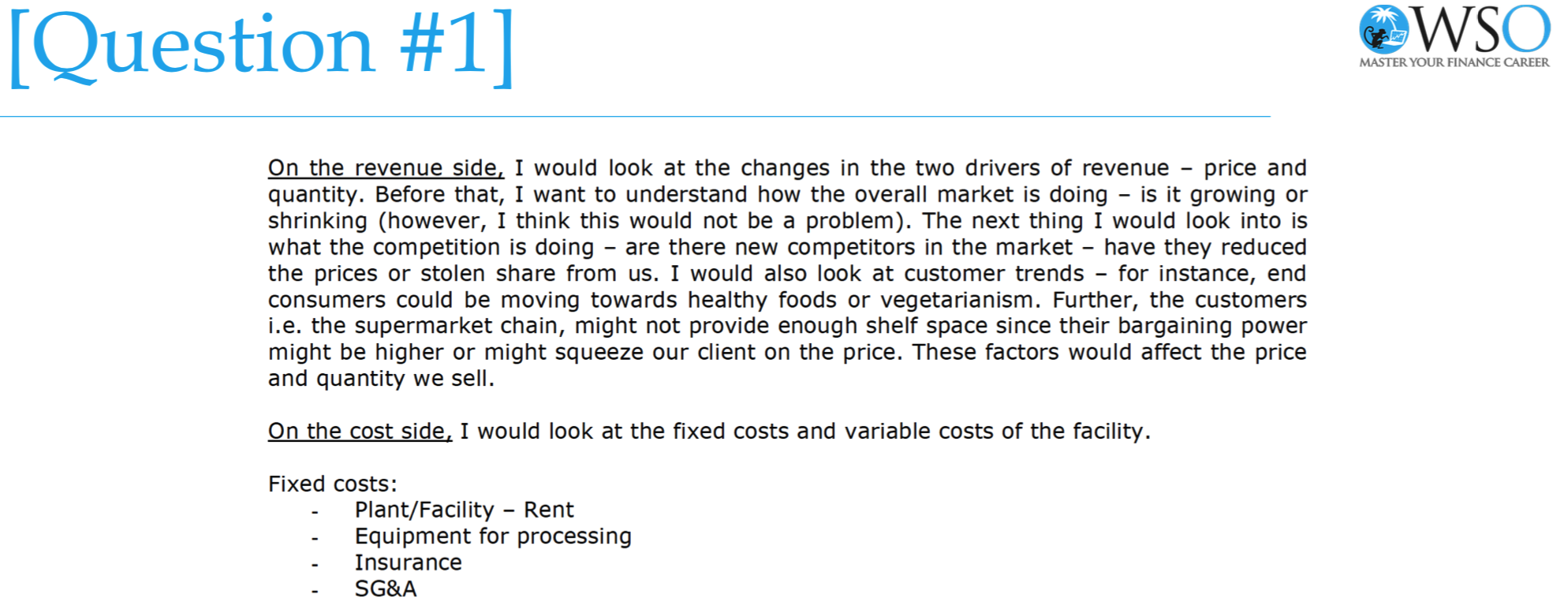
Everything You Need To Break into the Top Consulting Firms
Land at an Elite Consulting Firm with the Most Comprehensive Case Interview Prep Course in the World.
More Resources:
We hope this template helps you excel at your job! Please check out the following additional resources to help you advance your career:
- BCG Case Template
- Company Drivers PowerPoint Template
- Company Overview PowerPoint Template
- Industry Analysis PowerPoint Template
- DCF Output PowerPoint Template

Get instant access to lessons taught by experienced private equity pros and bulge bracket investment bankers including financial statement modeling, DCF, M&A, LBO, Comps and Excel Modeling.
or Want to Sign up with your social account?

IMAGES
VIDEO
COMMENTS
The hypothetical case of the global cosmetics company points to two common cognitive biases that can emerge when any company attempts to pursue programmatic M&A: the shiny-object syndrome and Maslow's hammer.. The shiny-object syndrome—also known as extreme distraction.Companies that continually chase down the next new thing run the risk of pursuing initiatives in the wrong order, skipping ...
Top M&A trends in 2024: Blueprint for success in the next wave of deals. February 20, 2024 -. Will 2024 launch a bright new era for M&A? Anticipating what could be an inflection point, many dealmakers are preparing for a surge—and new market requirements—in the year ahead. Article.
M &A can offer a powerful lever for executing strategy, transforming organizations, and delivering exceptional value creation. In this episode of the Inside the Strategy Room podcast, two McKinsey experts talk about how executives under pressure to create more value for shareholders and stakeholders can benefit from using a transaction as an ...
Undaunted by global disruption, a logistics company embraces bold transformation. December 2, 2022 -. ECU Worldwide, one of the largest less-than-container-load shipping companies in the world, chose to innovate during the COVID-19 pandemic, working with McKinsey to become tech enabled and revamp its organizational structure.
For years, our research has shown that taking a programmatic approach to M&A in the long term can significantly boost an organization's performance compared with its peers. Yet M&A execution is a very labor-intensive activity, requiring thoughtful allocation of resources and a balanced focus between integration activities and core business continuity.
9. Build capabilities for future deals—take full advantage of every opportunity to deepen the bench. M&A leaders treat each deal as an opportunity to upgrade their M&A team's skills and expertise. In banking M&A, talent is increasingly emerging as one of the primary sources of competitive advantage.
The best keep moving. We help clients do that wisely and effectively. Seamless end-to-end delivery. From strategy and capital planning all the way through the final steps of integration execution, we help clients identify the best path to shareholder value. Translating strategy into action. Few companies align their strategy and M&A program ...
At McKinsey, we strive to create an unrivalled environment for exceptional people. During many of our interviews, you will learn more about what this value means in practice at McKinsey. Your assessor may share details of how McKinsey is a non-hierarchical, diverse, inclusive meritocracy. They may touch on our formal and informal apprenticeship and mentor programs.
To better understand the practical application of the GE-McKinsey Strategy Framework in M&A, let's examine a case study involving MediCool Health, a US-based healthcare organization, and HealthAI ...
Previous McKinsey research has found that programmatic M&A—that is, carefully choreographing a series of deals around a specific business case or M&A theme, instead of pursuing more organic, episodic, selective, or large transactions—is far more likely to lead to stronger performance and less risky for any organization. FOBs seem to be ...
M&A cases are common case types used in interviews at McKinsey, Bain, BCG, and other top management consulting firms. A typical M&A case study interview would start something like this: The president of a national drugstore chain is considering acquiring a large, national health insurance provider.
McKinsey - Overview of M&A, 2016 (2016) McKinsey - Five keys to unlocking growth in marketing's "new golden age" (2017) ... Good inspiration for: Presenting a trend and following with a good example/case study. Download the presentation here.
Acquiring Capabilities through M&A: A Case Study in Retail Industry. Mastering M&A Strategy: How the GE-McKinsey Framework Enhances Decision-Making and Drives Long-Term Growth. Mergers and acquisitions (M&A) have become an essential part of many organizations' growth strategies. The complex nature of these transactions demands a structured ...
Mergers and Acquisitions Case Interview Walkthrough: McKinsey-Style. Thanks for registering for the live case walkthrough with advanced degree candidate Yuan Cai. Jenny Rae pushed Yuan in a non-traditional McKinsey M&A case, followed by direct feedback on her strengths and weaknesses. Find the recording below, and write to us with any follow-up ...
McKinsey research has found that the healthiest organizations generate three times higher returns than companies in the bottom quartile and more than 60 percent higher returns compared with companies in the middle two quartiles. 1 Scott Keller and Bill Schaninger, Beyond Performance 2.0: A Proven Approach to Leading Large-Scale Change, second ...
Breaking Down Case Interview Frameworks - M&A (Mergers and Acquisitions) Updated November 01, 2023. Welcome back to the last in our series on breaking down case interview frameworks. You've almost made it to the end of our series! By the end of this article, you'll be well on your way to applying the mergers & acquisitions framework and ...
Prepping for a McKinsey interview? Get expert coaching: https://bit.ly/3QbC77VIn this Mergers and Acquisitions Case Interview Walkthrough, Jenny Rae (the int...
McKinsey Case Interview. Updated November 17, 2023. The McKinsey case interview is different than the case interview you will receive at BCG, Bain, or another top consulting firm. This means that you must prepare strategically. While best practices are consistent across different case styles, at some point, simply preparing for general case ...
McKinsey case prep program: https://managementconsulted.com/consulting-prep-resources/Welcome to another case interview walkthrough. This episode features Ad...
Jorge Amar: We have estimated that gen AI enterprise use cases could yield $2.6 trillion to $4.4 trillion annually in value across more than 60 use cases. 1 "The economic potential of generative AI: The next productivity frontier," McKinsey, June 14, 2023. But how much of this value is realized as business growth and productivity will depend on how quickly enterprises can reimagine and ...
One of the best ways to prepare for case interviews at firms like McKinsey, BCG, or Bain, is by studying case interview examples.. There are a lot of free sample cases out there, but it's really hard to know where to start. So in this article, we have listed all the best free case examples available, in one place.
For more practice, check out our article on 23 MBA consulting casebooks with 700+ free practice cases.. In addition to M&A case interviews, we also have additional step-by-step guides to: profitability case interviews, market entry case interviews, growth strategy case interviews, pricing case interviews, operations case interviews, and marketing case interviews.
Let's step through them one by one and list the questions you'd want to answer in each. 1. The market. The first area consultants typically analyse in M&A cases is the market. This is extremely important because a big part of the success or failure of the acquisition will depend on broader market dynamics.
Common case interview frameworks include: Profitability Framework. Business Situation Framework. McKinsey M&A Framework. 4P and 7P Frameworks. Porter Five Forces Model. External vs Internal. Qualitative vs Quantitative. Cost vs Benefits.
If 2022 was a tale of two halves, with robust fundraising and deal activity in the first six months followed by a slowdown in the second half, then 2023 might be considered a tale of one whole. Macroeconomic headwinds persisted throughout the year, with rising financing costs, and an uncertain growth outlook taking a toll on private markets.
Download WSO's free McKinsey Case PowerPoint template below!. This template allows you to work through a McKinsey-style case on your own.. This plug-and-play template allows you to walk through the case at your own pace.The sample case also includes other slide pages for other elements of a case interview.According to the WSO Dictionary, "A case interview is a job interview in which the ...